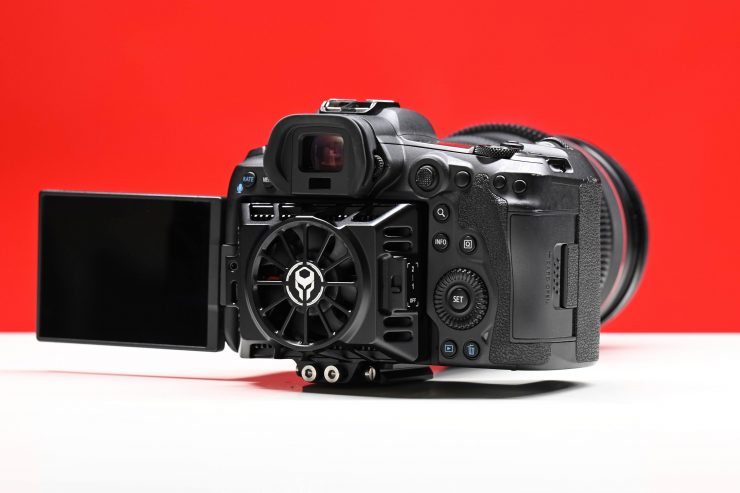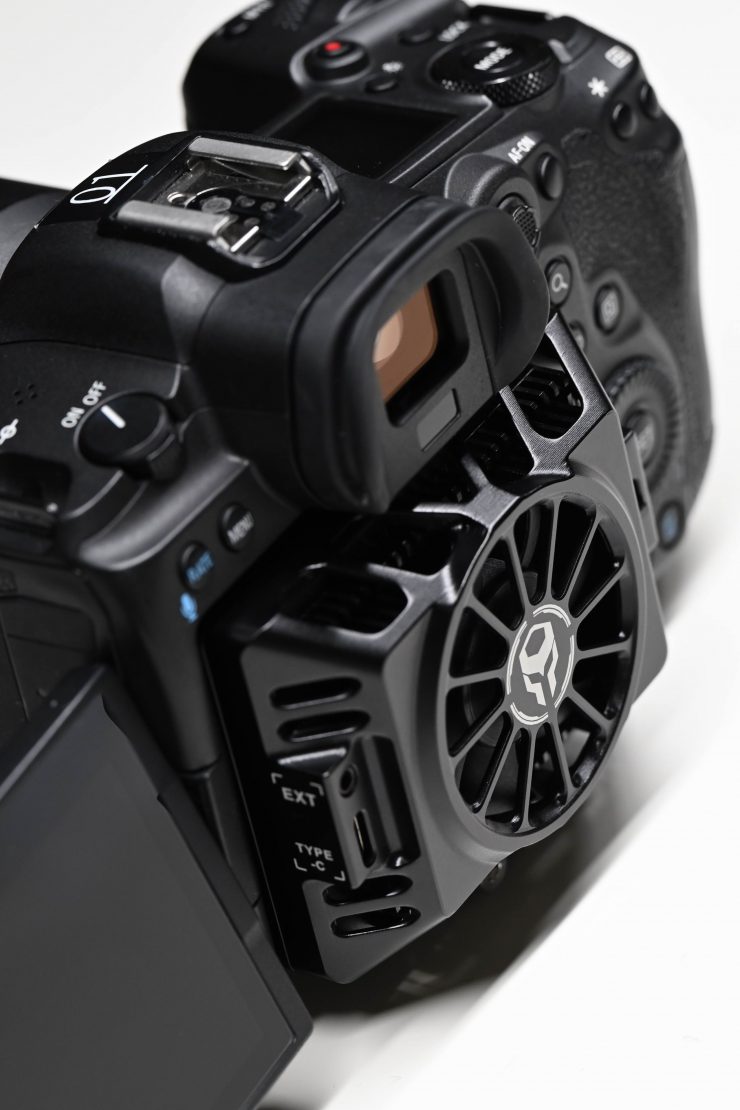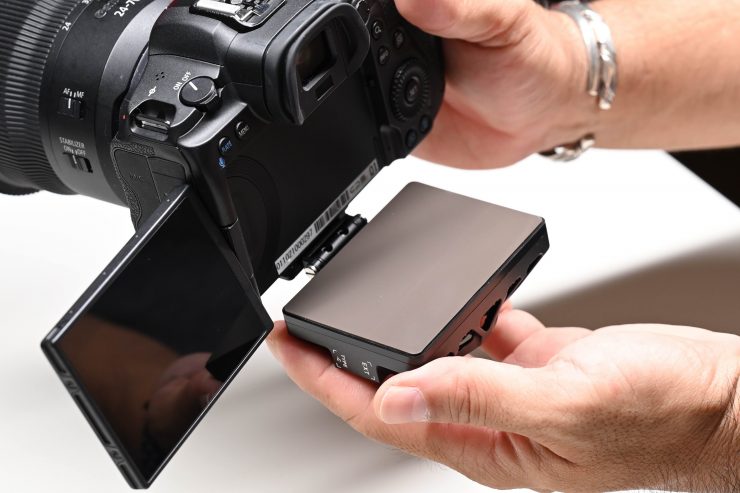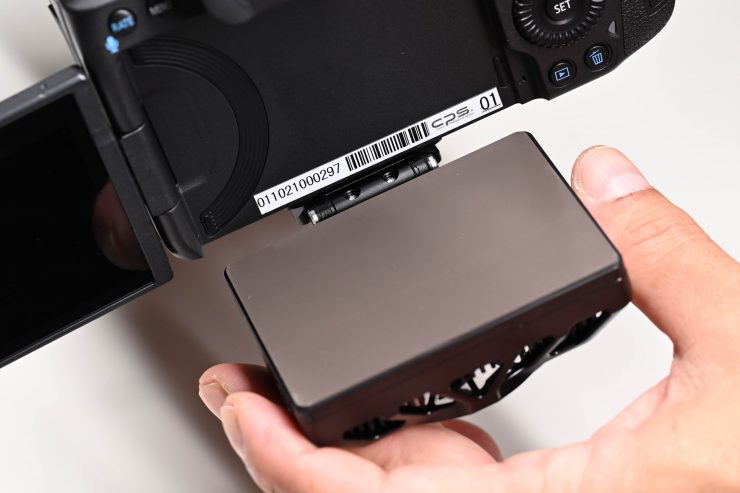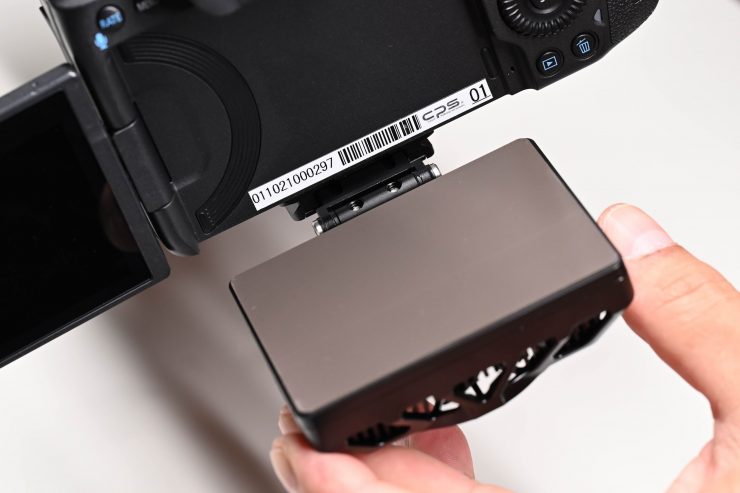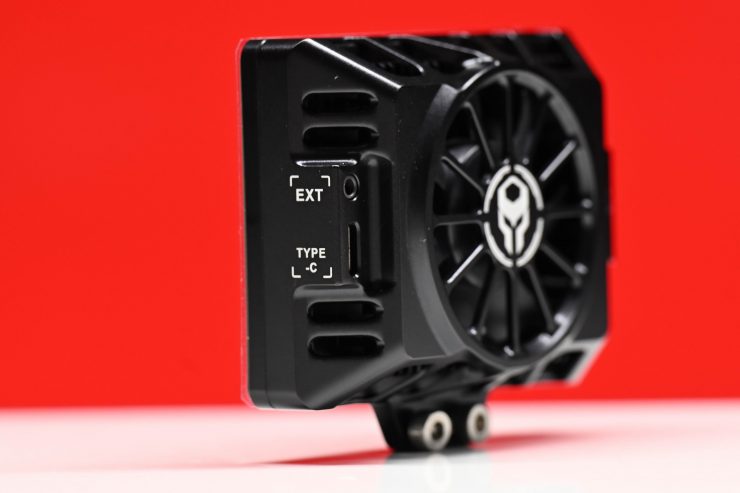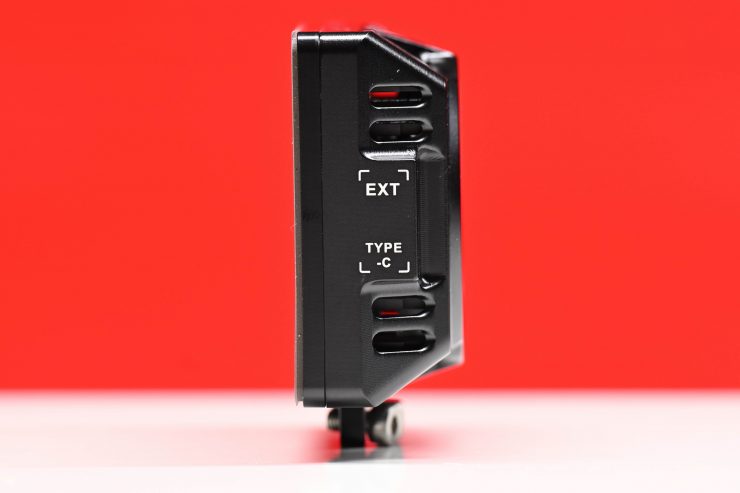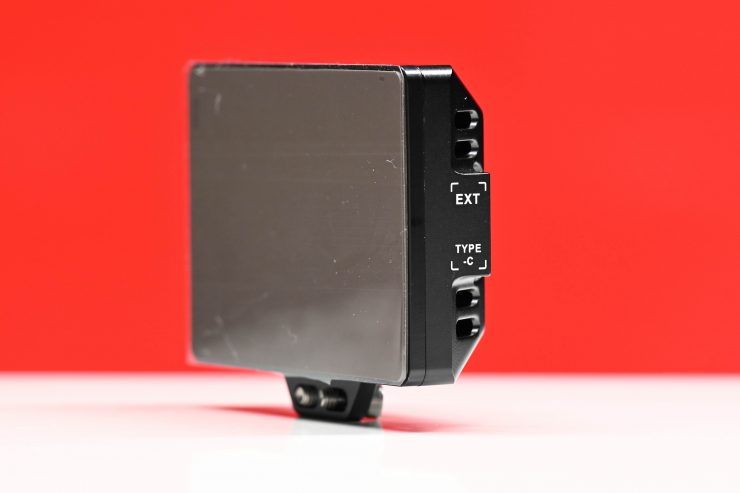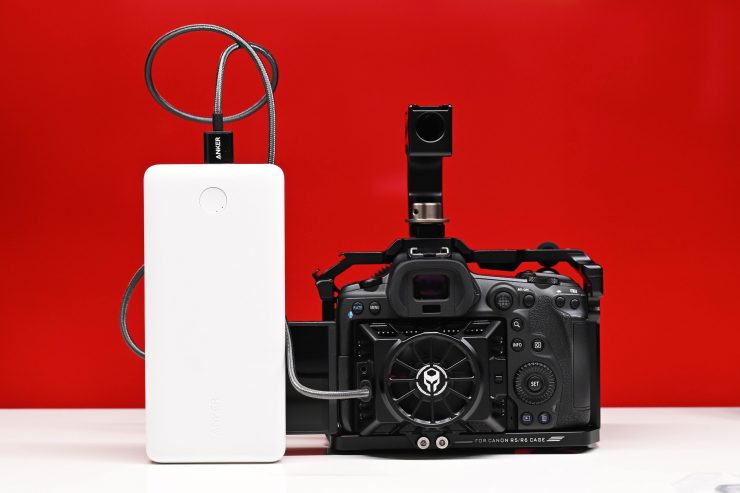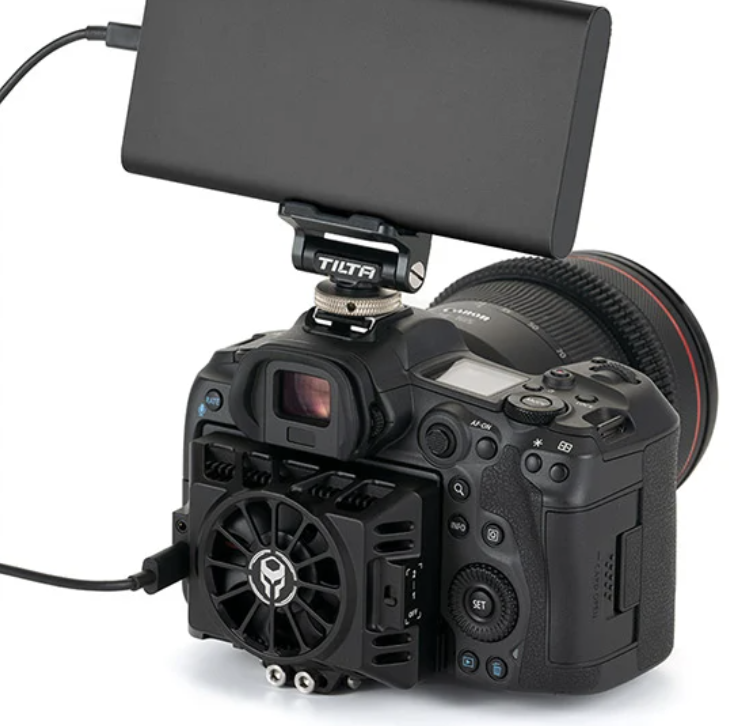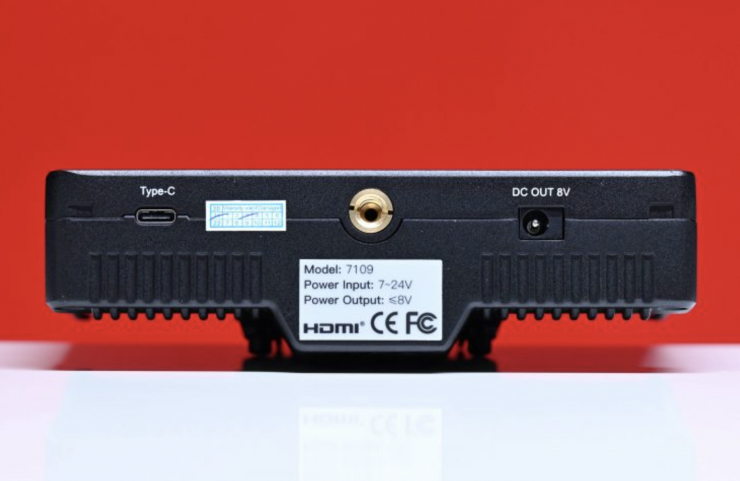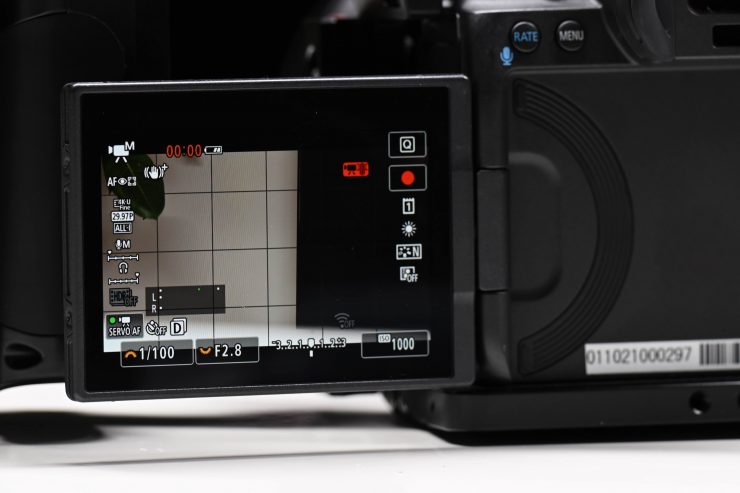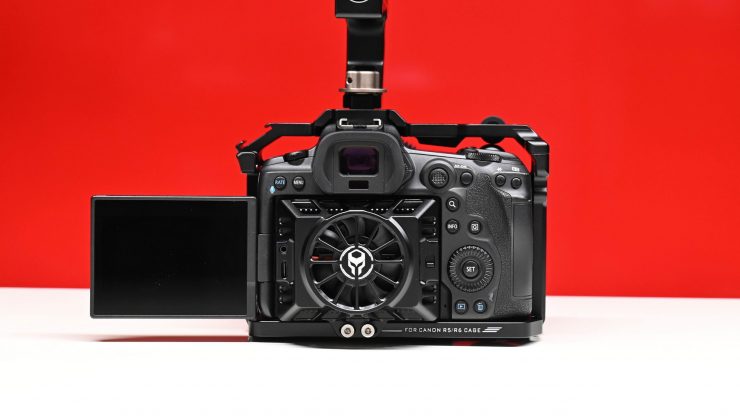
The Tilta Cooling Cage for the EOS R5 was announced way back in July 2020. At the time I think a lot of people thought that this must have been some sort of joke.
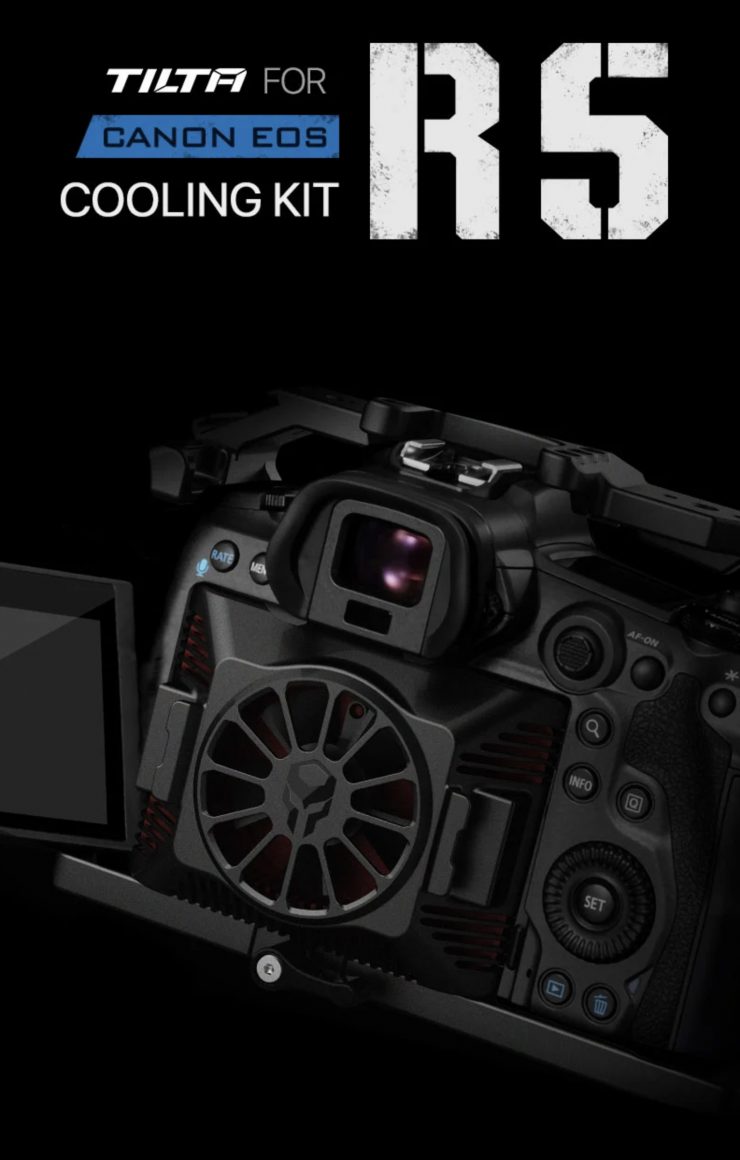
Tilta showed what was essentially a giant fan attached to the back of the camera. This announcement came right around the time when the internet was losing its mind over numerous reports of overheating issues with the EOS R5. Tilta then took it upon themselves to come up with a solution. Back in July 2020 when I first wrote the article, I too was skeptical, and I didn’t think this was a product that would ever come to market.
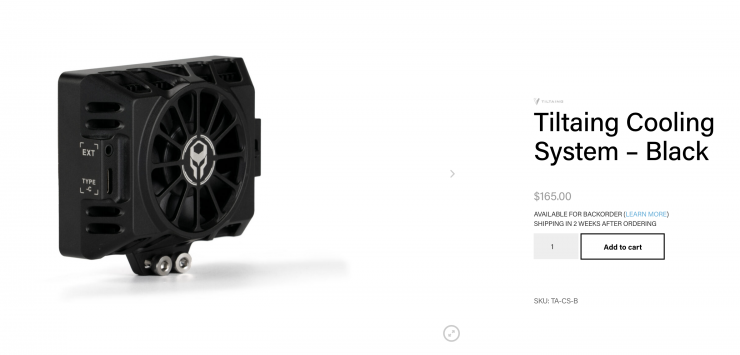
Well, a couple of weeks ago, in somewhat of a surprise, Tilta announced that you can now actually buy the R5 Cooling Kit.
Before we get into the Tilta R5 Cooling Unit, I am going to go down a bit of a rabbit hole here and give you some background information on the whole R5 overheating issue. If you aren’t interested in going down that hole you can skip ahead.
What was the issue that actually caused this product to be announced in the first place?
The EOS R5 certainly bucked the trend of Canon crippling its mirrorless and DSLR cameras when it comes to video specifications. With the R5, Canon swung for the fences instead of deciding to bunt and play it safe. While Canon certainly pushed the technology envelope with EOS R5, that did seem to come at a cost, and that cost was that the camera could overheat in various resolutions and formats. Just be crystal clear, the R5 didn’t overheat in every mode, it was just limited to a few.
It isn’t as if Canon hid the problem of overheating or recording limitations, however, they arguably didn’t do a very good job of explaining it. The subsequent PR storm certainly didn’t help their cause. Here is what I wrote in my article when the EOS R5 was first announced:
What about the heat?
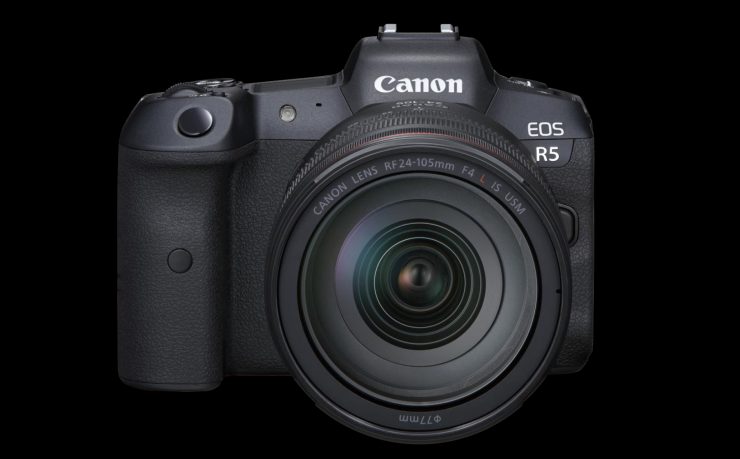
Surely recording 8K RAW is going to produce an awful lot of heat, so how is Canon cooling the camera given it doesn’t utilize a fan like the Panasonic S1H? Well, I’m glad you asked. Canon claims that it is keeping the heat under control through the use of the new DIGIC X processor in combination with CFexpress card read/write speeds. This combination means less buffering as data can be transferred extremely quickly from the camera to the card. This, in turn, helps reduce heat.
Now, this doesn’t mean the R5 isn’t going to have some heat issues, because it is. If you are recording 8K RAW or 4K HQ and the recording limit is reached, or your card fills up, and you then press record again or put in another card and keep recording, you will eventually get heat warnings. These will appear in the viewfinder and on the LCD screen. If you are working in hot environments or wanting to record 8K RAW for hours and hours you are going to run into problems.
Canon is clearly stating that the video recording time of the Canon EOS R5 is limited by heat. Here is what they say:
8K movie recording (RAW, DCI, UHD) has restrictions on possible recording time due to the temperature rise. Max possible recording time is approx. 20 min. (at room temperature).
4K 60p movie copped recording has restrictions on possible recording time due to the temperature rise. Max possible recording time is approx. 25 min. (at room temperature).
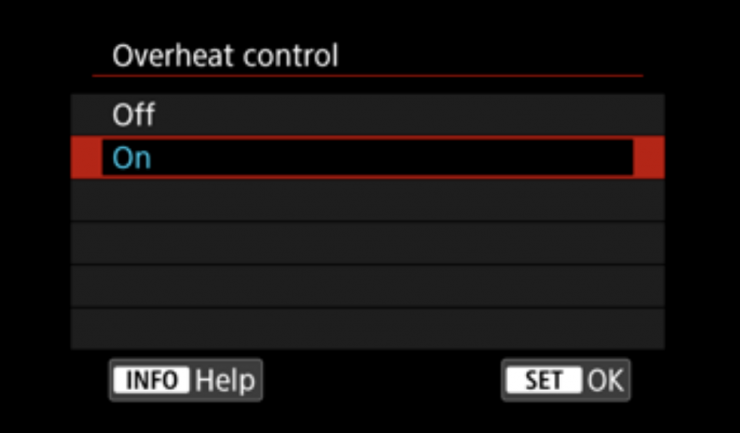
[Overheat control] is a new setting in EOS R5 and EOS R6 that temporarily changes display details such as resolution or displayed frame rate in movie
recording standby, to help prevent the camera from becoming hot internally during standby periods. As a result, image quality on the standby screen may differ in quality from image quality on the screen during movie recording.
Canon was always going to have to make a compromise with the R5 when it came to heat. By going with a fully weather-sealed body and not including any type of fan, heat was always going to be an issue. You can’t have your cake and eat it too. There is a reason digital cinema cameras have large cooling systems.
Look, heat limitations are clearly not great, but as long as you understand the limitations of the camera and use it appropriately you shouldn’t run into too many problems.
I can already hear the cries of `It isn't professional because it has heat limitations.’ The camera is clearly capable of being used in certain professional environments and anyone who knows what they are doing won’t try and use it in situations or environments it shouldn’t be used in. In saying that, real-world testing in a variety of different shooting scenarios and situations needs to be done to determine if those heat issues will be something that affects the way you work. If you need long record times and you are going to be working in hot environments this isn’t the right camera for those jobs.
Don’t buy an R5 and then complain about these problems. You should clearly know what the limitations of any camera are before purchasing.
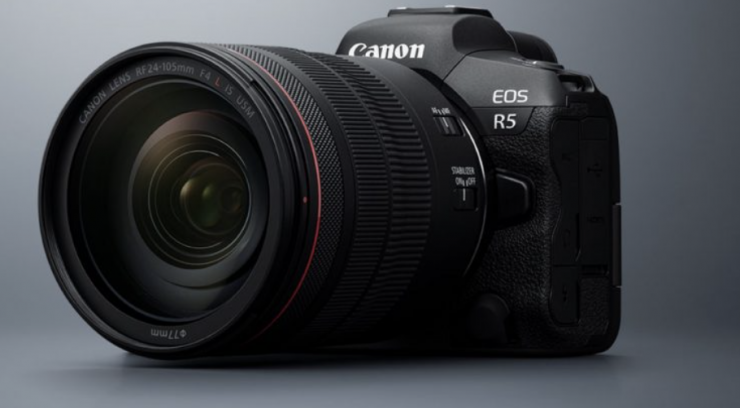
I think the biggest issue wasn’t that the camera overheated, it was the recovery time it took before you could shoot again and how limited that time was.
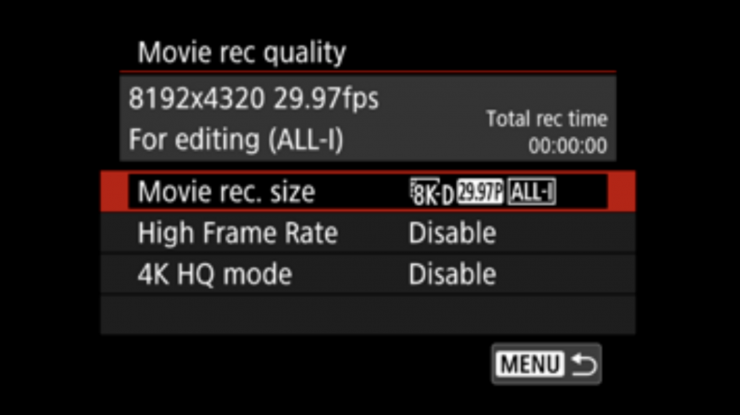
With Canon copping a lot of heat and ridiculous rumors of a product recall flying around, Canon eventually issued a statement:
The EOS R5, one of the latest additions to Canon’s full-frame mirrorless camera line, offers class-leading autofocus with high-resolution and high frame rate video recording options using the maximum width of the full-frame sensor at high bit rates. Inevitably, this combination of features has the potential to generate some significant heat, which will limit recording time.
Canon has taken several steps to manage the potential for overheating, including:
- Magnesium alloy was used in the body to dissipate heat away from internal components
- An “overheat control” function to reduce heat generation when the camera is in standby
In regard to the installation of a fan: The decision not to install a fan within the body was made in order to maintain the EOS R5’s compact size, lightweight construction and weather resistance.
Before recording starts, the EOS R5 and EOS R6 display an estimate of the recordable time based on the current camera temperature and the set recording mode.
Canon has published and included below the approximate recording and estimated recovery times for 23°C / 73°F environments and ensures that the camera will warn users when it is getting too hot. Additionally, tips to reduce overheating as well as recovering time are listed below.
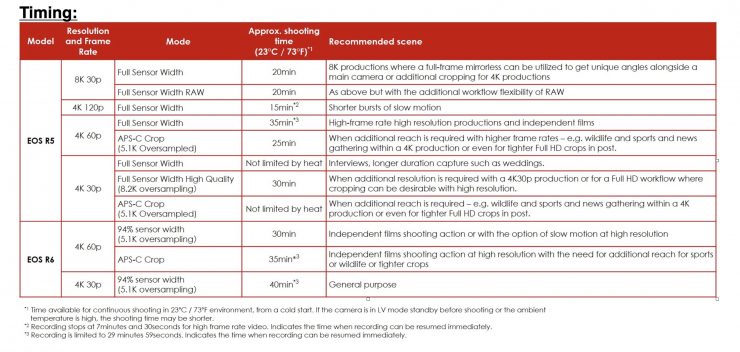
How can you reduce heat buildup in the EOS R5?
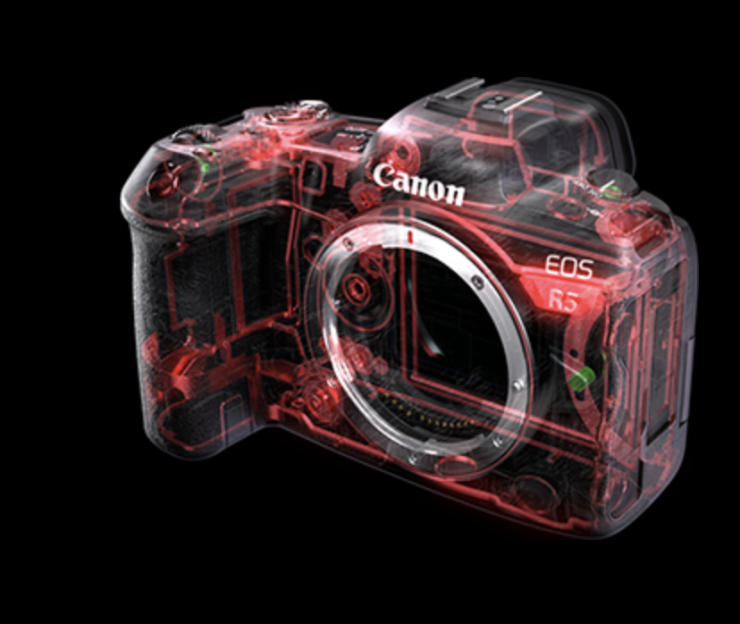
This is what Canon recommends:
Set Overheat Control function to “ON” (default). When the overheat control function is enabled, the movie size and frame rate are automatically changed while the camera is in standby mode to suppress the rise of the internal temperature.
Between recordings, it is recommended to turn off the camera and position the camera out of direct sunlight. You can also use an external fan to dissipate heat.
How long will it take for the camera to recover?
Estimated camera recovery times are indicated below. The time until full record time is available will vary with ambient temperature, continued camera operation, and the selected shooting resolution.

While there is pretty substantial hindering of recording times when shooting 8K or 4K HQ, these are unlikely to be modes that the majority of users are going to shoot in for extended periods of time.
What you need to clearly note, is these downtimes listed by Canon are for working in conditions where the ambient temperature is 23 C / 73 F. If you are working in much hotter conditions then the waiting times and subsequent recording times are going to be increased and decreased respectively.
If you do want to record a lot of 8K or 4K HQ then one option would be to have multiple camera bodies, but that is not going to be a financially viable option for a lot of users.
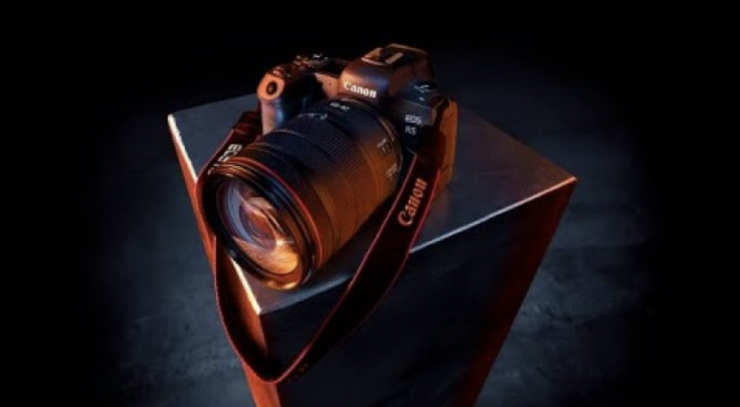
After that statement, a firmware release eventually came out on August 27th, 2020:
Canon has released Firmware Version 1.1.0 for the EOS R5 that will incorporate the following fixes and enhancements:
- [Overheat control: on] settings are no longer disabled when HDMI display: Camera + External monitor is used and a message to inform users is shown
- The in-lens image stabilization performance during movie recording has been improved for certain RF lenses
- Temperature detection and shooting time control in video shooting have been improved. In addition, the total shooting time when the short-time recording and power-on/off are performed repeatedly at room temperature is improved.
- A phenomenon in which the movie recording time available is not correctly displayed when the Date/Time/Zone is not set has been corrected
- Fixes a phenomenon in which the “Slow Synchro” setting screen is not displayed correctly when the language is set to English
- Fixes a typo displayed on the communication setting screen, when the language is set to Korean
- Connectivity during FTP transmission has been improved
- Fixes a phenomenon, in which the card access time may take longer, when using certain CFexpress cards

According to Canon, ‘The effect of the new firmware addresses consumer concerns around repeated shooting capabilities and the need for improved cooling while switched on. We have and will continue to be transparent about recording limits for the EOS R5 and are confident that the camera performs to stated specifications.’
The route cause of the R5’s recording limitations in certain modes was a timer chip that was in the camera that was working independently of the temperature chip. What this new firmware was essentially doing was to tell the camera to ignore the timer and instead listen to the temperature data.
This firmware update and subsequent firmware updates did go some way to alleviating the issue, but it didn’t completely solve it. You can’t just magically make the camera not overheat through a firmware update. The overheating issue is directly related to the internal design of the camera.
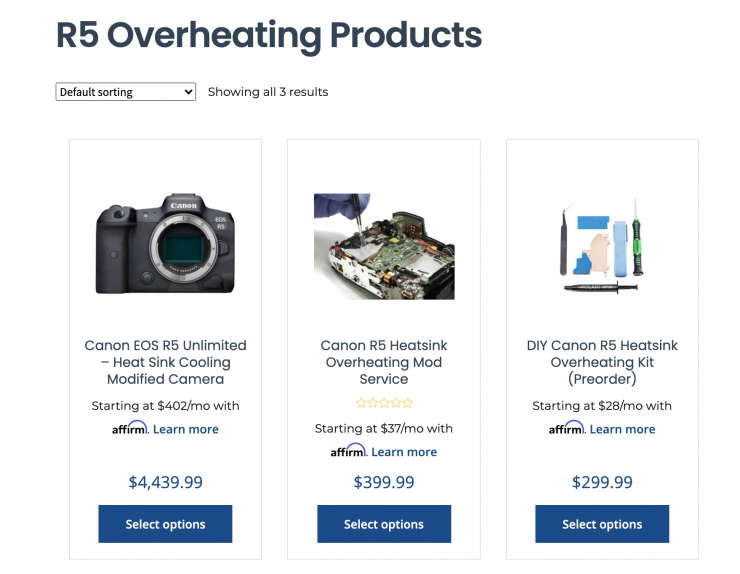
There were all sorts of DIY hacks and ideas being floated around on the internet for improving recording times, including Kolari’s passive R5 cooling solution.
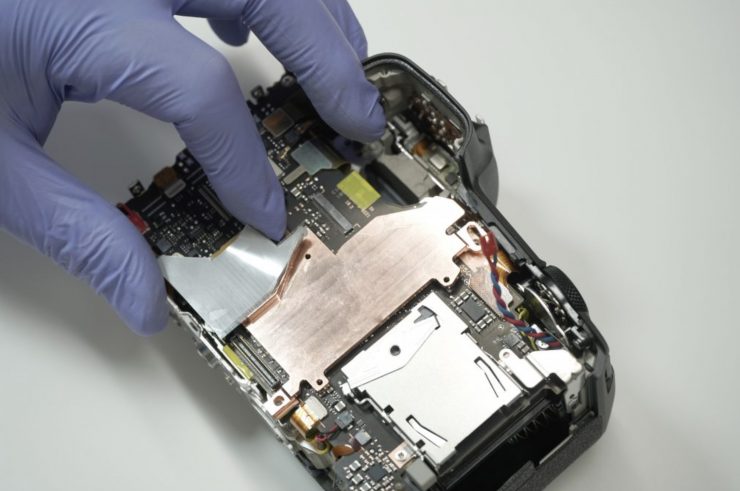
This is a heatsink overheating modification where the R5 is taken apart and a new heatsink is installed to vent the heat from the processor to the camera case where it can dissipate faster. This design is claimed to draw heat out of the processor and bring it around the motherboard and out to the rear case where it transfers heat through a high-efficiency thermal pad. This design is fully internal to the camera and maintains the weather sealing of the camera.

Kolari claimed that they tested the modified camera at 8K-D IPB 30FPS at 59F (15C) and 69F (20C). At 15C, the R5 never overheated. At 20C, where the
stock camera lasts around 25 minutes, with the Kolari mod, the camera lasted for 44 minutes, almost two times the initial shooting duration. What’s even more important, is that the camera was claimed to recover a lot faster after it did overheat, giving more shooting time after a short recovery. With the stock camera, they could only get about 8 minutes of additional shooting after a 5-minute recovery, where the mod was able to shoot for 25 minutes after the same 5-minute recovery.
Please note that these are claimed times and I cannot independently verify them. Again, I am not sure what they were doing with this test as you can’t record 8K internally for more than 20min continually. I can only guess that the camera stopped recording and they hit record again.
What Kolari also found is that the modification’s performance can be negatively impacted by certain CF Express memory cards. Their tests were conducted using Sony Tough CF Express cards. What Kolari found is that ProGrade CF Express cards can cause greatly decreased heat dissipation performance.
So back to Tilta
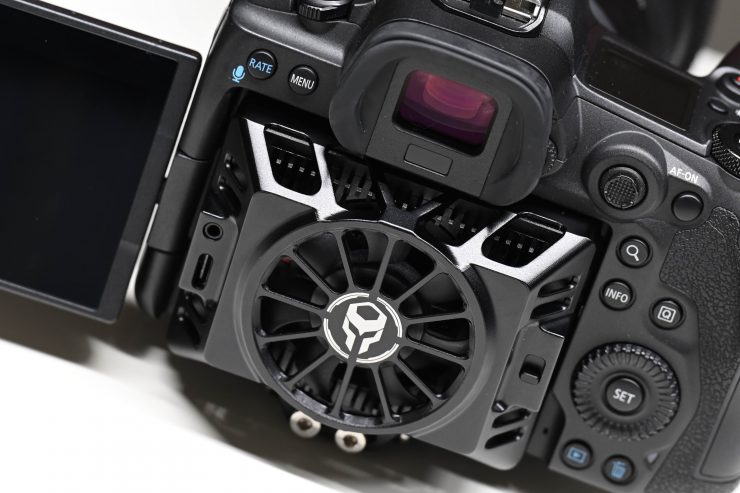
Now that you have some background on the overheating issue, let’s look at the Tilta R5 Cooling Unit.
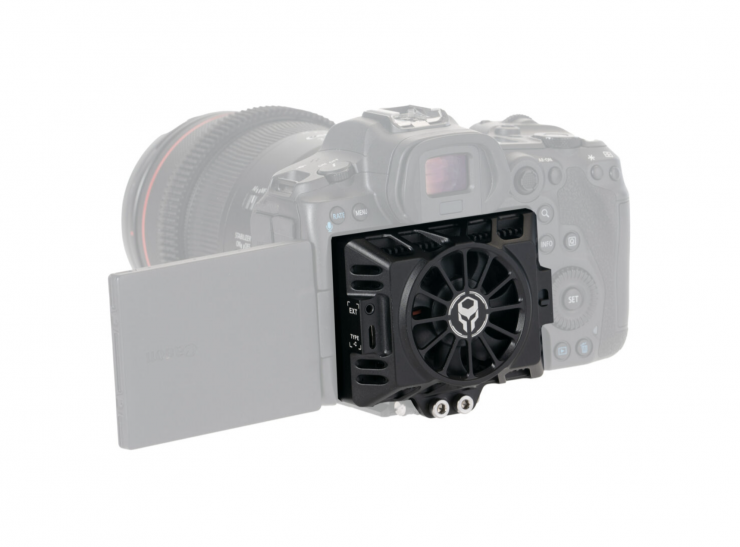

Shipping version 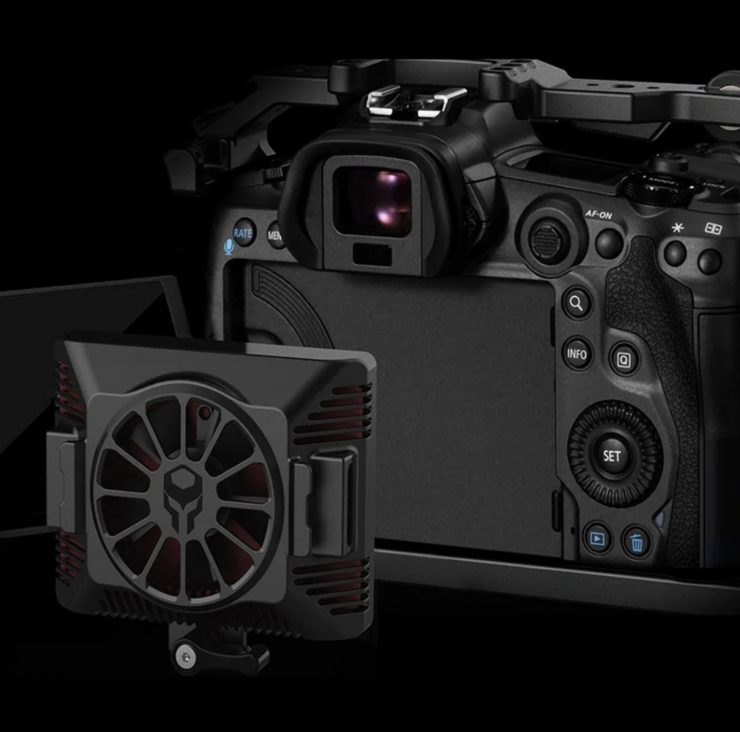
Original concept
Above you can see the difference between the production version and the original concept that was shown back in July 2020.
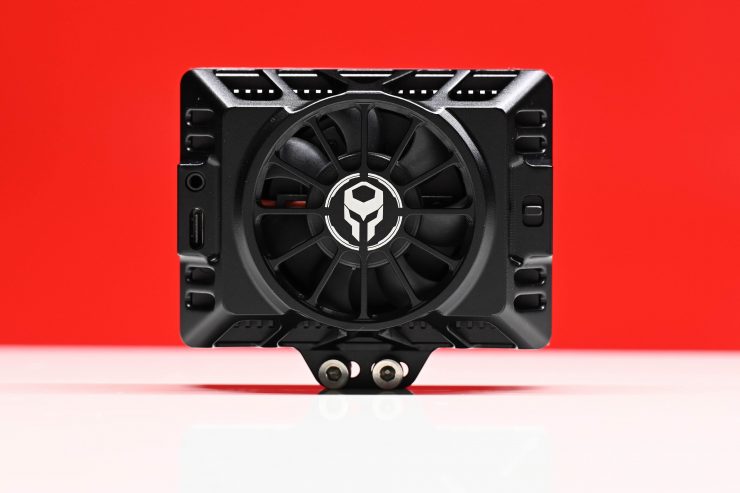
The production version doesn’t look to have been changed that significantly from Tilta’s original design.
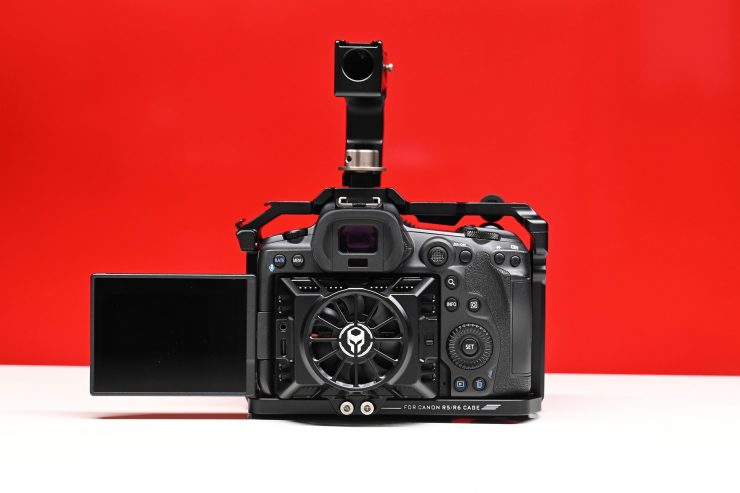
The Tilta Cooling Kit is designed to be used with the company’s Tactical Camera Cage or ARCA Baseplate for Cooling System so you can use it with existing equipment. The fan sits in the body cavity of the R5 behind where the screen flips out.
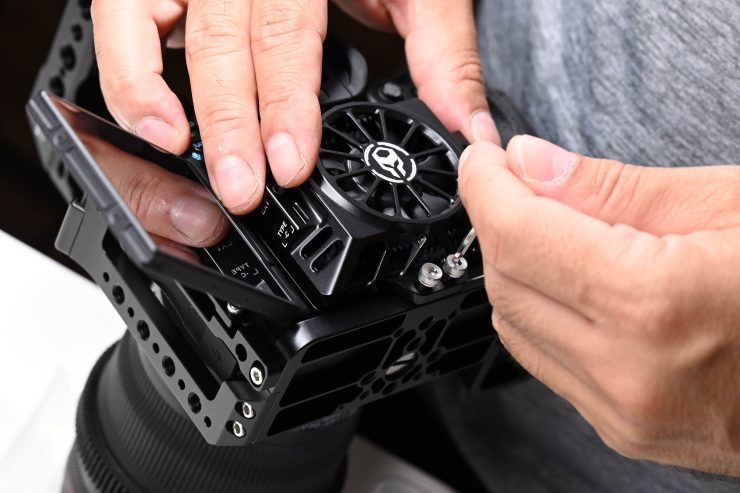
It attaches via two screws directly to the bottom of the Tilta Tactical Camera Cage for the R5/R6. It is very easy to install. Now, this isn’t a permanent installation, you can simply undo the screws and take the cooling unit off when you don’t need to use it.
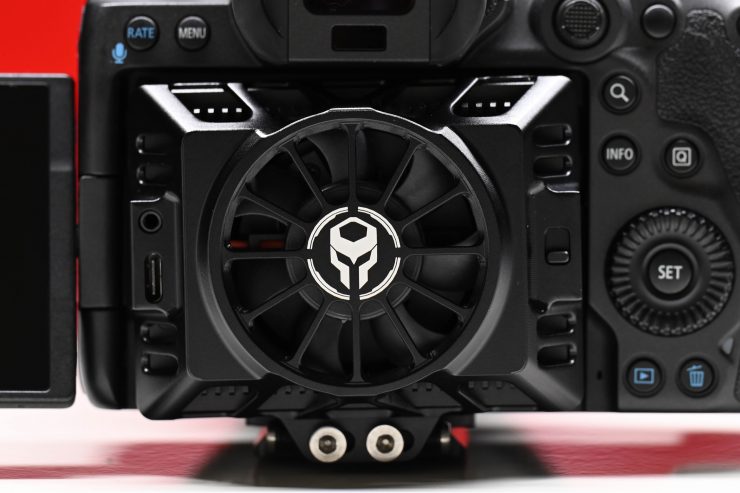
If you don’t want to place it on a Tilta cage, you can just install it using the ARCA Baseplate for Cooling System.
This bracket also features an articulating hinge, which lets you swivel the entire module away from the camera body, allowing you to flip the screen back into a closed position.
Build Quality
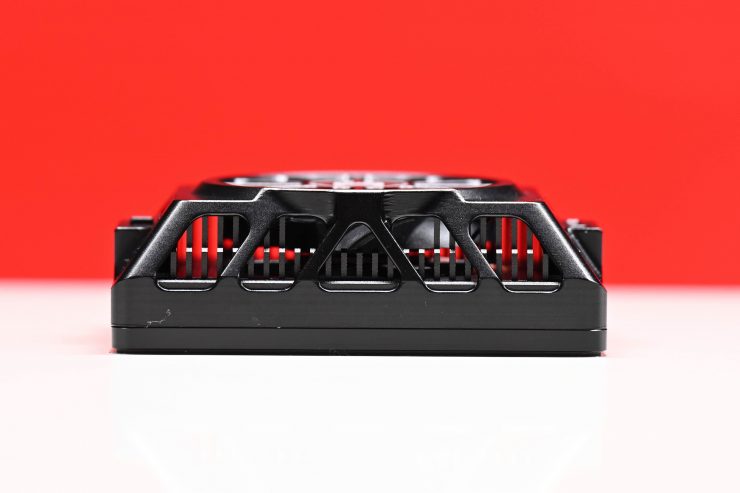
The Tilta Cooling Unit is very solidly made. It actually has a little bit of weight to it. It tips the scales at 195g / 6.87 oz.
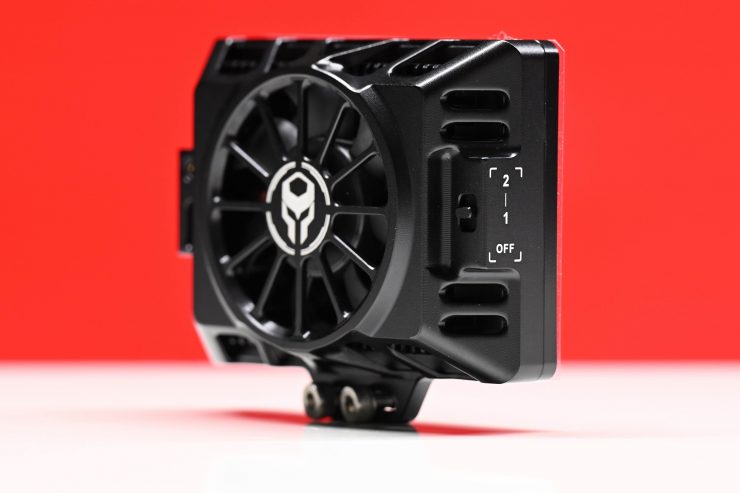
The switch for the fan is tactile and not at all flimsy.
Fan
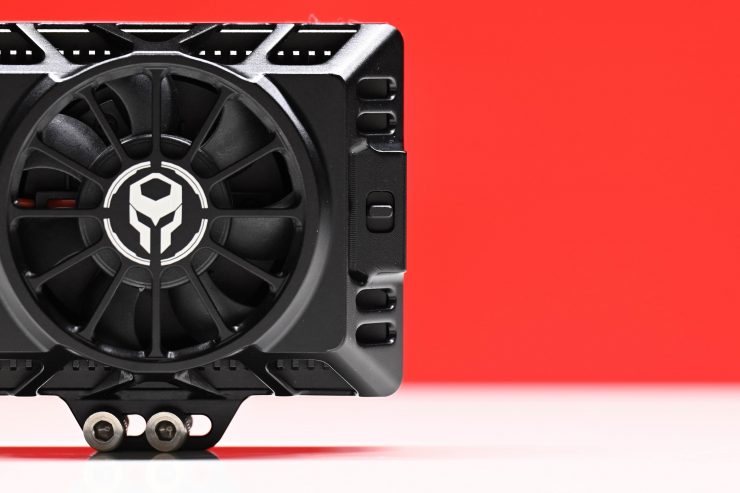
The fan itself has 7 blades and it runs at 5000rpm. Tilta claims that the noise level produced is lower than 30db, I will test this in my review. There are three settings for the fan:
- Off
- Low Speed
- High Seed
The Cooling Unit is also said to use an NTC smart temperature control switch. This allows it to turn on and off depending on the temperature and if there is any build-up of moisture.
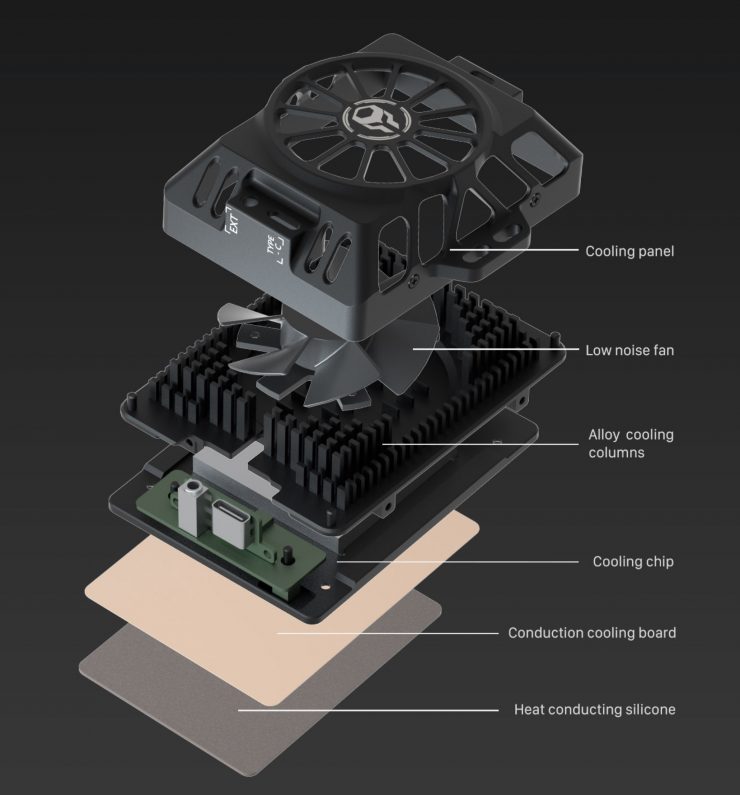

Shipping version 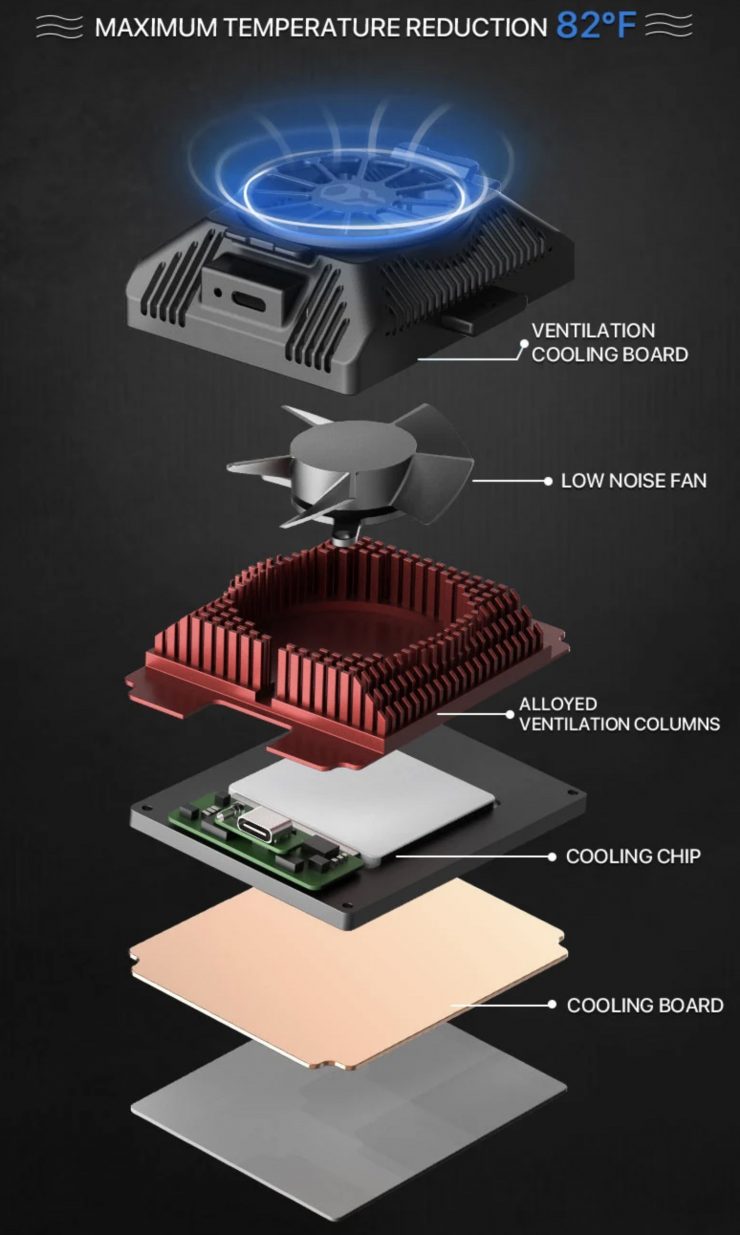
Original concept
The fan consists of a cooling board, a low noise fan, alloy cooling columns, a cooling chip, a cooling board, and heat-conducting silicone. The whole idea behind how it works is that it is supposed to draw away heat from the back of the camera and then disperse that heat.
What is it designed to do?
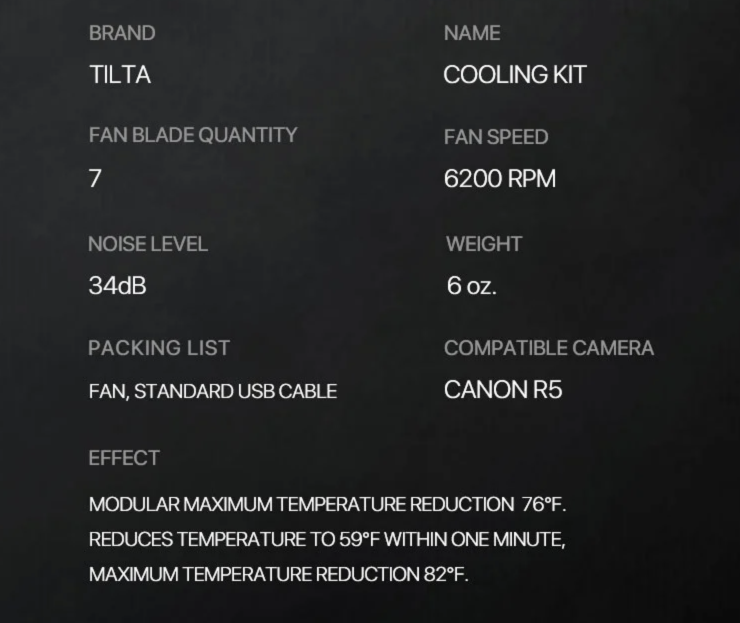
It is interesting to see that Tilta has removed the original claims that were on its website that stated that that the temperature of the camera can be reduced to just 59°F (15°C) within 1 minute. They also listed that the maximum temperature reduction was 82°F (27.8°C).
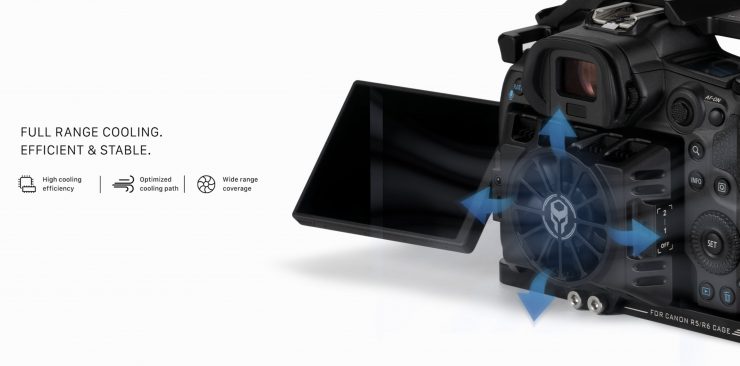
On the current product page for the R5 cooling unit, Tilta doesn’t list any details about temperature reduction, nor do they make any claims about how effective it is.
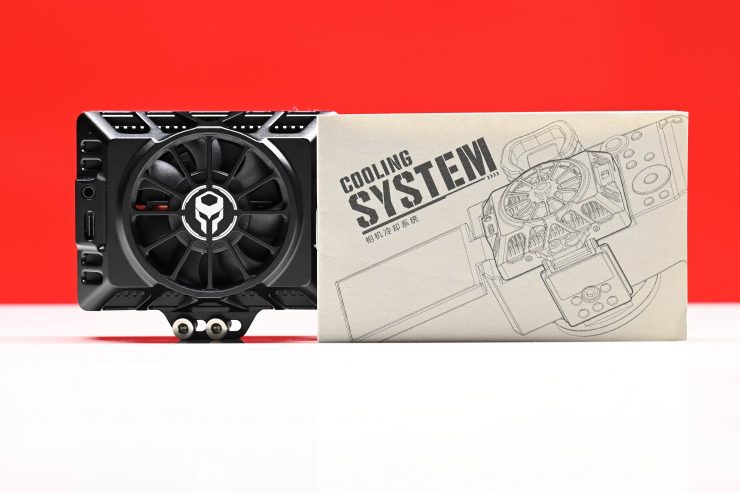
However, the operating manual that you get for the R5 Cooling Unit does make some claims. Here is what it states:
8K-D 25P RAW Cooling Test- Input Voltage 5-7.4V
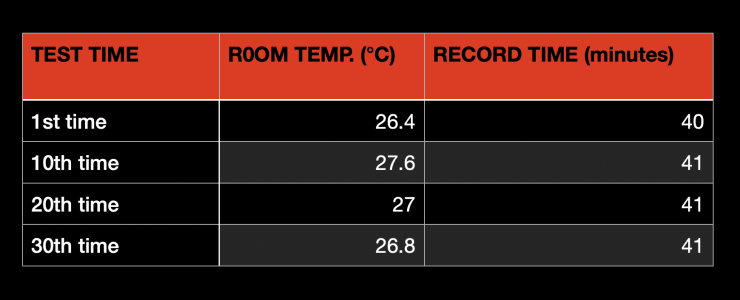
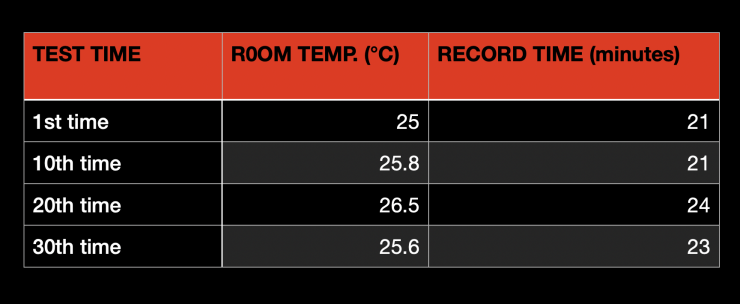
8K-D 25P RAW Cooling Test- Input Voltage 8V
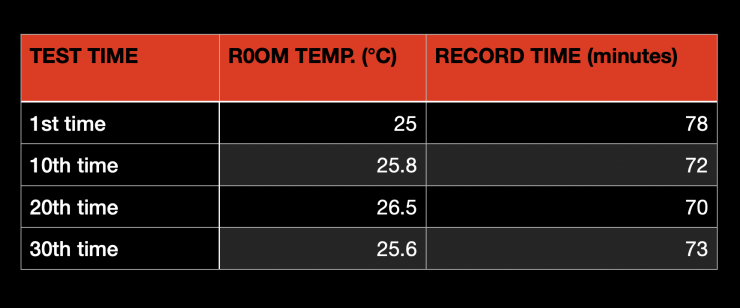
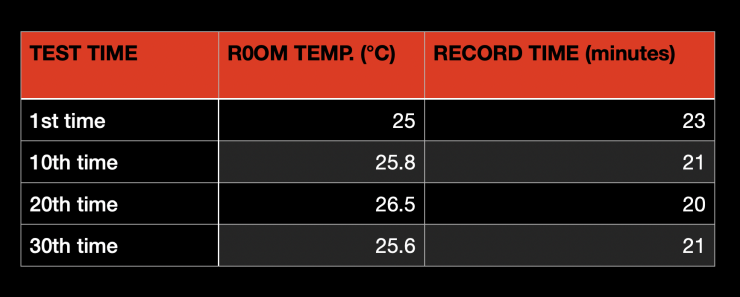
These claimed figures are certainly a massive improvement over standard, but the trouble is, nowhere does it state how long the recovery time was before you can record again. You also can’t internally record continuously for more than around 20min when shooting 8K because of the recording time limitation, so I am not sure what Tilta was actually doing with these tests.
They also don’t list what card was being used, or if the AF or IS was turned on. They also don’t say what fan mode was being used.
I will do my own tests to see how the R5 Cooling Unit performs. You will be able to see those further down in the review.
According to Canon, internally the Canon EOS R5 can only record 8K RAW up to a max duration of 20min, but it generally will overheat before it reaches that time.
How do you power it?
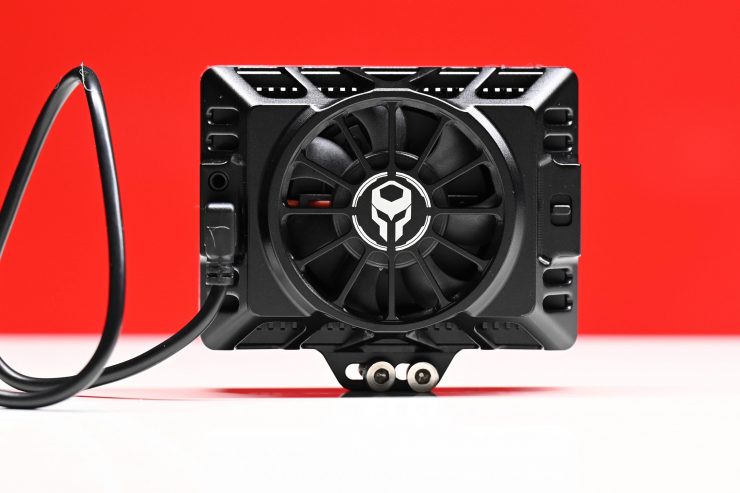
The R5 Cooling Unit doesn’t feature an in-built battery so you need to power it via its USB-C input. The USB-C input can handle either 5-12V (3-5A). Tilta claims that 8V and higher will provide better results. The USB-C input is on the left and side of the Cooling Unit.
The difficulty is where do you get your power from? Nobody really wants to mount a large USB-C capable power bank on top of their camera. Yes, you can find smaller-sized ones, but again, you still need to find a place to put it.
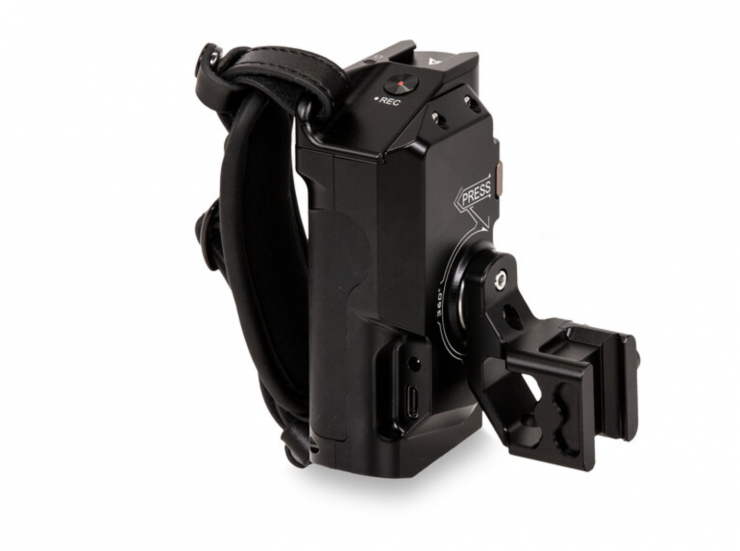
If you want something that delivers 8V or 12V to the USB-C input then that is a little more tricky. The easiest way is to probably just power it by using Tilta’s own Canon R5 camera cage and the Tiltaing Tilta Left-Side Advanced Power Handle with Run/Stop. This handle takes a Sony F570 battery and it has a USB-C output on it. If you use this in conjunction with the R5 Cooling Unit you can power it easily. The Tilta Left-Side Advanced Power Handle with Run/Stop is able to supply an 8V USB-C output for powering the R5 Cooling Unit.
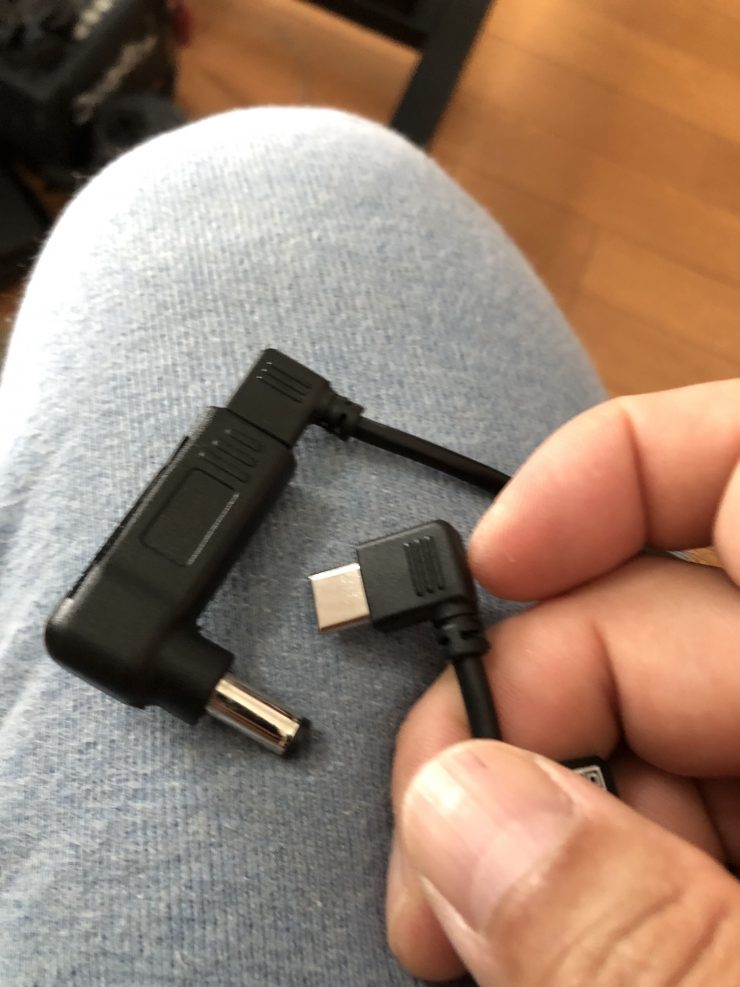
If you have one of those monitors that have an 8V DC output for powering cameras, you could just use a DC to USB-C adapter cable and power the R5 Cooling Unit that way as well.
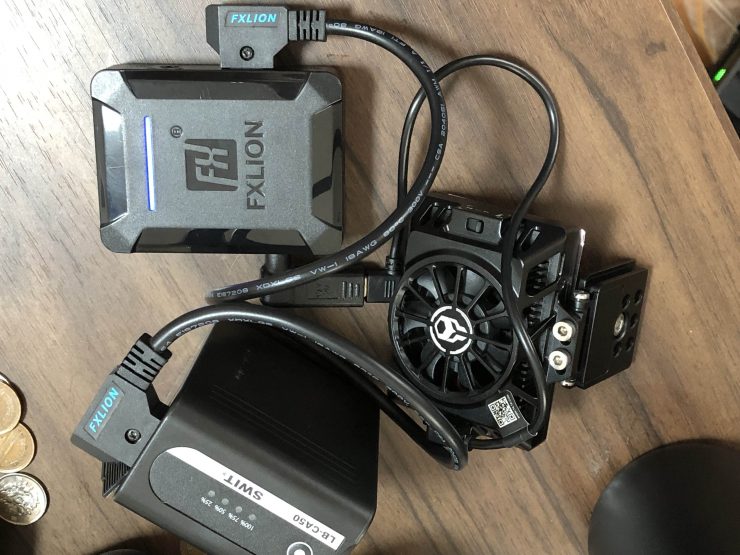
Now, if you want to power it via 12V you could use something like the FXLion NANO HUB. This has the ability to output 12V/3A over USB-C. You could also output 12V/3A through the DC out and just use a DC to USB-C adapter.
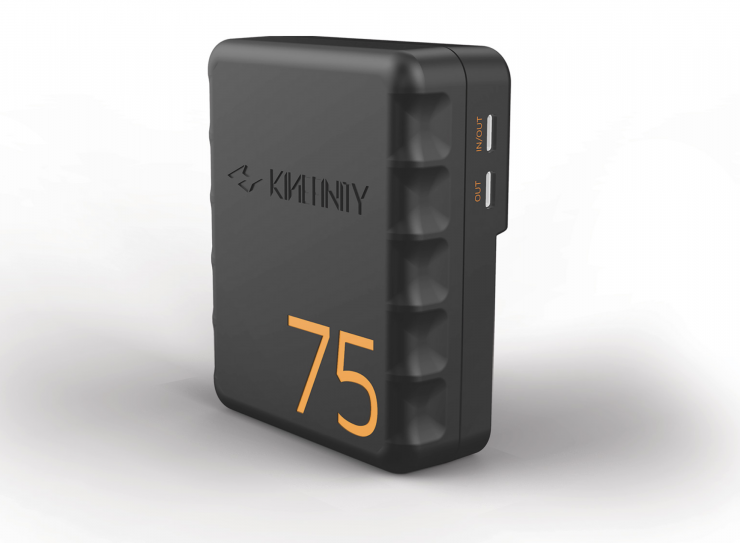
In theory, some camera batteries that have USB-C outputs should be capable of powering the R5 Cooling Unit. The Kinefinity PD KineBAT has a USB-C output that can provide 12V/3A. However, I tried this and it didn’t appear to work.
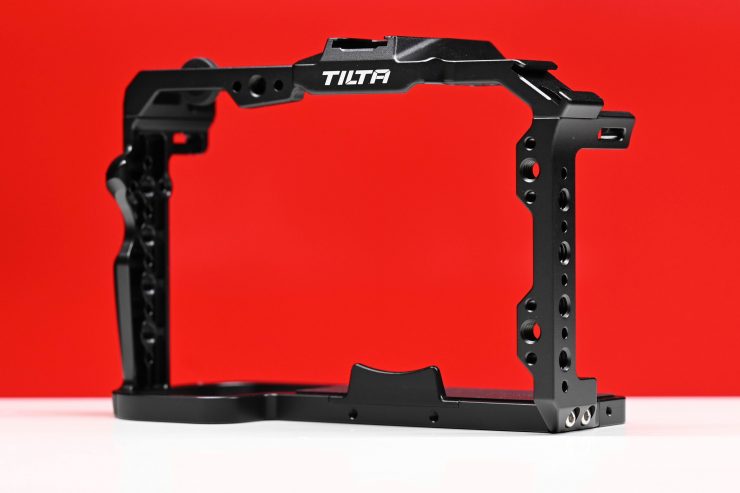
The only problem with the Tiltaing Tilta Left-Side Advanced Power Handle with Run/Stop, is you are going to have to attach it to the Tilta cage or another cage using a Nato rail.
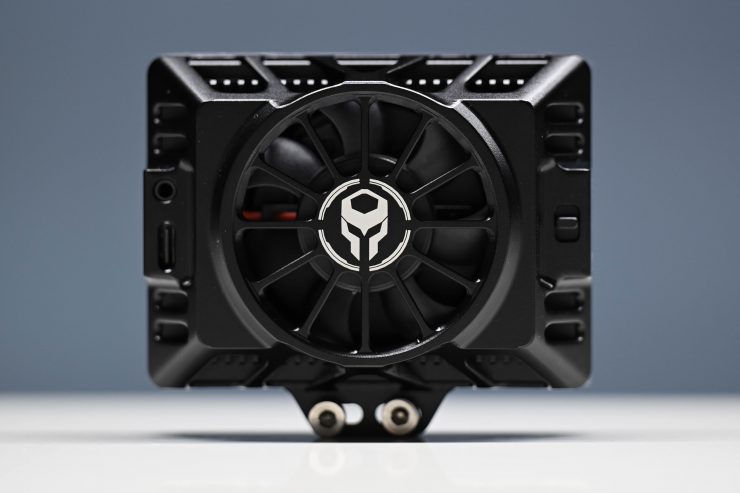
The R5 Cooling Unit also features an EXT port for run stop cables. This EXT port is for connecting the Nucleus Nano R/S cable to the camera. R/S can be controlled via the R/S handle.
Usability?
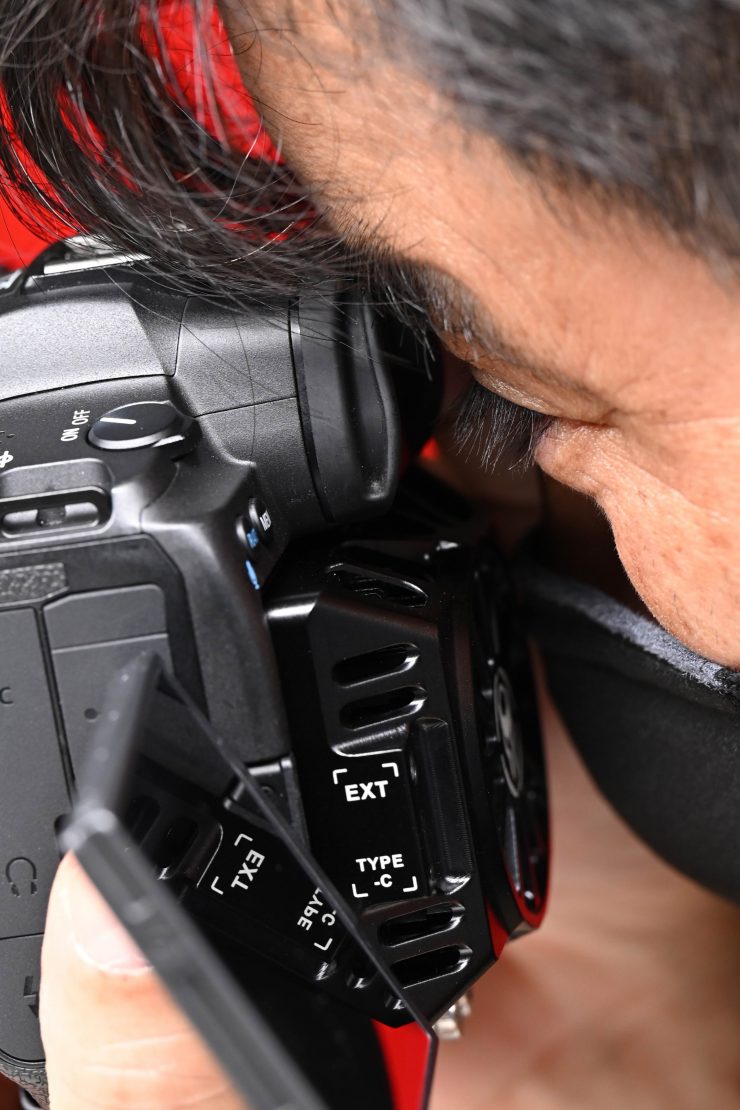
Straight of the bat, there are going to be a few glaring obvious problems when using the Cooling Unit. The first is that you have to keep the rear screen out and away from the camera body, and if you are going to put the camera up to your eye and use the viewfinder, the fan blows hot air straight into your eyes.
If you use it with Tilta camera Cage and the HDMI protector plate then the screen has very limited movement.
If you don’t use the HDMI protector plate, then the range is a lot better.
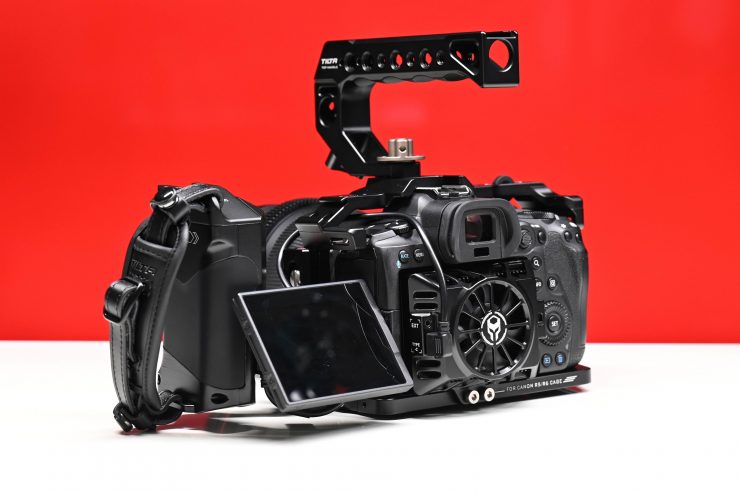
The trouble if you use the R5 Cooling Unit with the Tilta Cage is that if you want to close the screen back up against the camera body, then the Cooling Unit just stays out in an awkward position. This is not good if you are trying to put the camera away or place it into a bag.
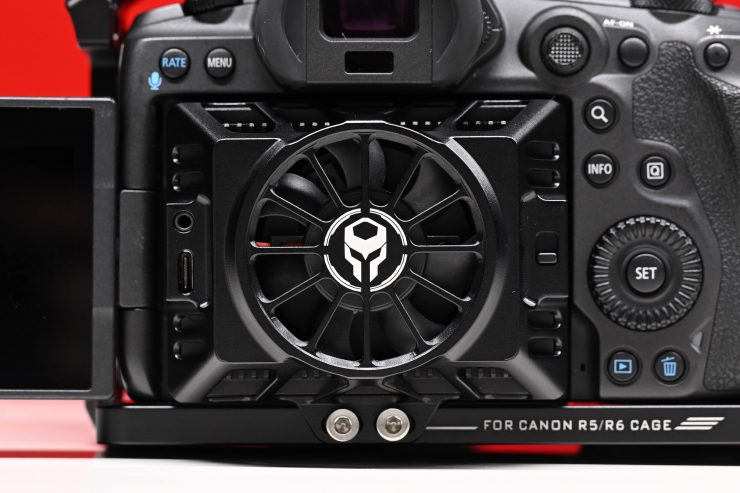
To take it off you need to undo the two screws holding it onto the cage. I would have prefeed to have seen some sort of solution for the cage where either a quick-release mechanism was used.
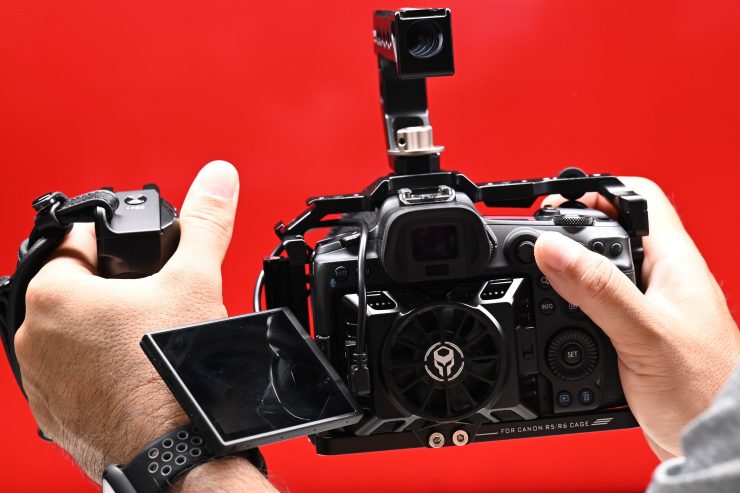
You also need to power the Cooling Unit so you will need to attach some sort of USB-C power bank to the cage or use something like the Tilta Advanced Side handle. In the above picture, it may look like the screen can’t move across properly because of the side handle, but we didn’t have the correct Nato rail to use with it, so it is sitting further back than it normally would.
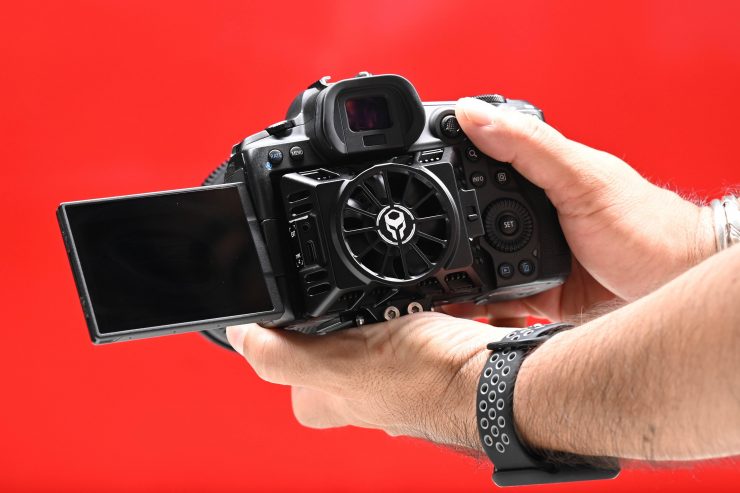
Usability is actually a lot better if you don’t use the R5 Cooling Unit with the cage, but then you can only power it by placing a USB-C power supply on the hot shoe.
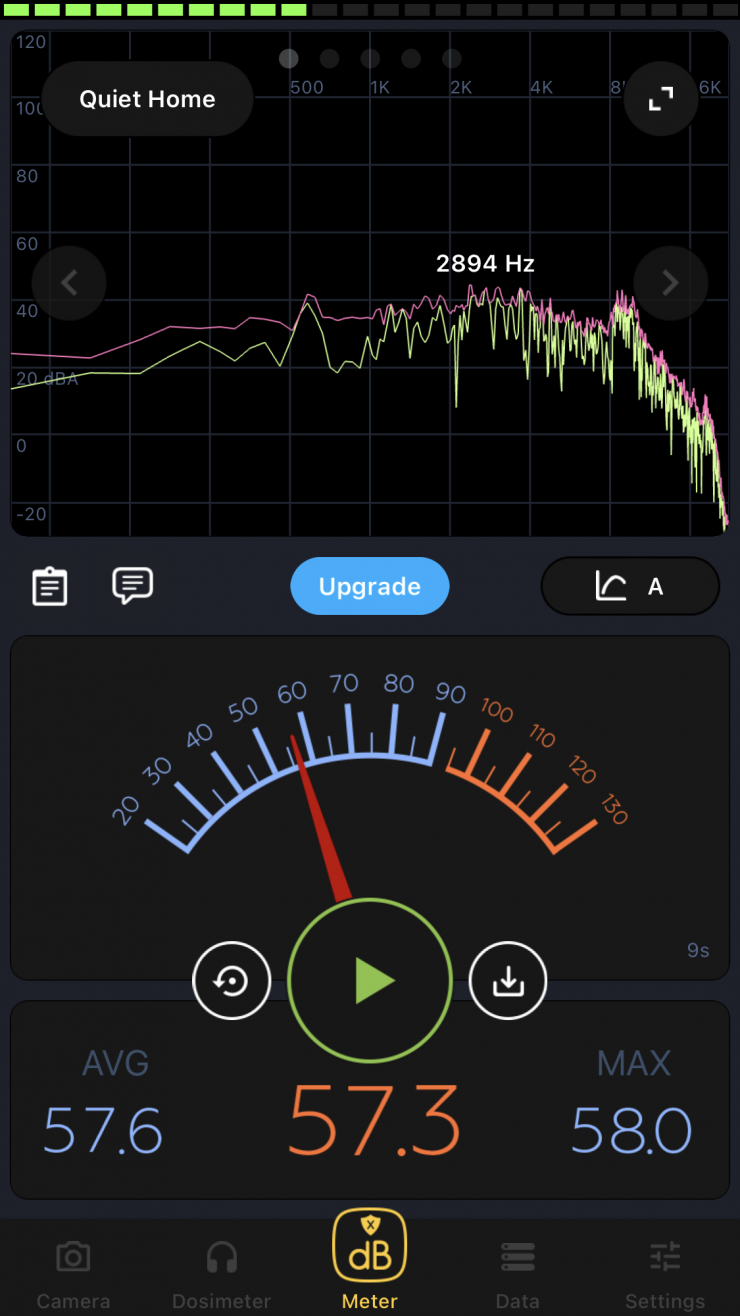

30cm behind the camera 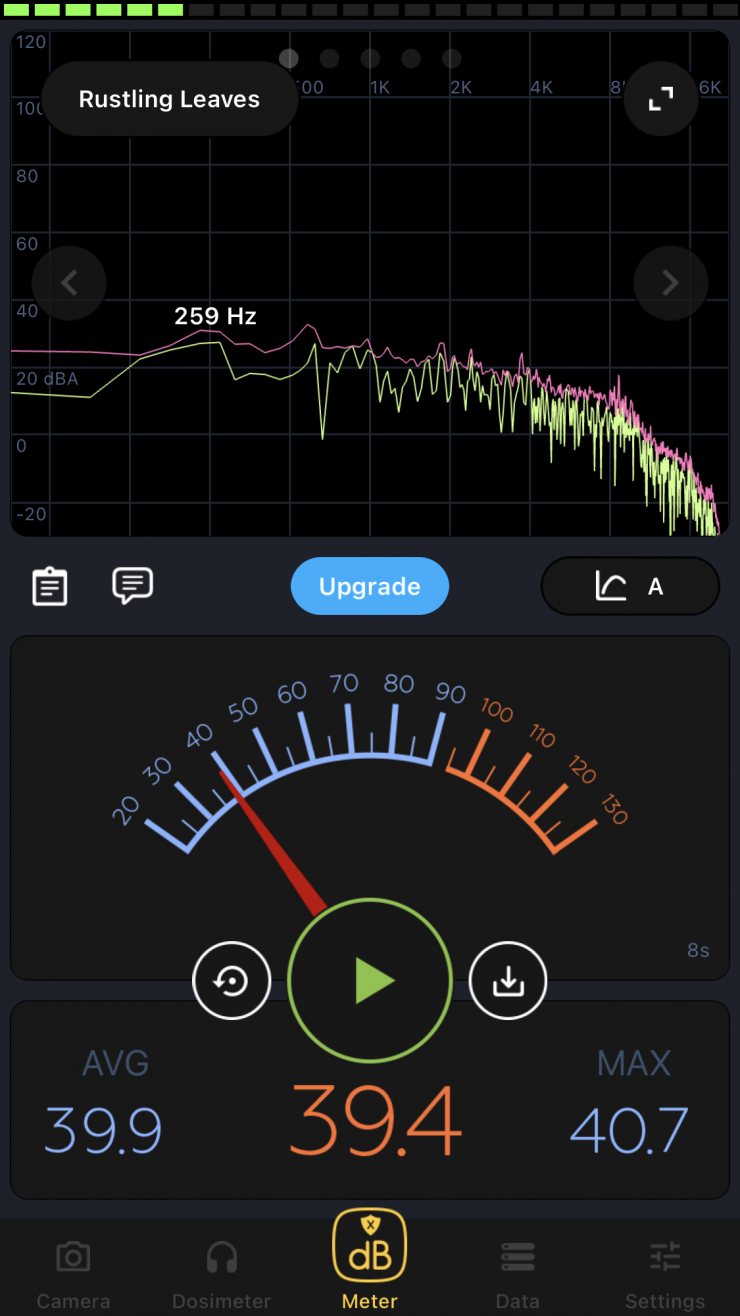
1m in front of the camera
The fan is also pretty noisy. I tested how much noise it was making in the High mode and found that 30cm behind the camera the average was 57.6db. Even 1m in front of the camera the average reading was still 39.9db. This is pretty loud and you couldn’t record audio from any onboard microphone or record sound within a few meters of the camera.
Tilta claims that the fan level doesn’t exceed 30db, but that must have been measured in the medium fan setting because the high fan setting is way louder than that.
The Medium fan setting isn’t nearly as noisy, but you still probably wouldn’t want to be recording audio from an onboard microphone.
Does it actually work?
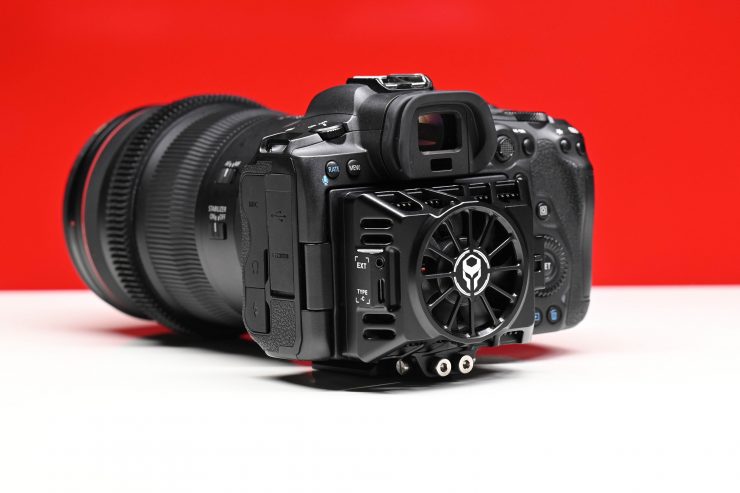
This is the million-dollar question. Just to be clear and upfront, I am not an engineer or a specialist in thermal dynamics. The tests I am conducting will be real-world tests to see if this product actually works.
4K HQ Test

So, for the first test, I set the camera in 4K HQ mode at 29.97p and had the AF on continuous and the IS turned on. The card being used in the R5 was a Prograde Cobalt 325GB. I did this exact same test with and without using the Tilta R5 Cooling Unit. The Tilta R5 Cooling Unit was being powered via the Tilta Left-Side Advanced Power Handle with Run/Stop that can provide an 8V USB-C output. The cooling unit’s fan was set to High.
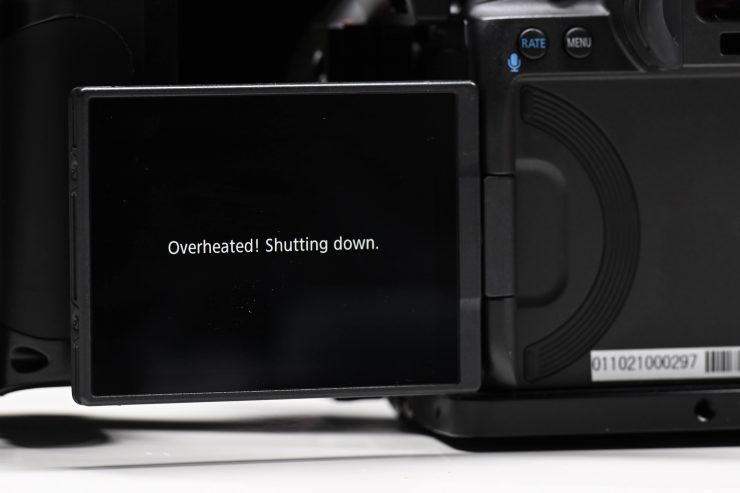
Without the cooling unit, the R5 ran for 29min and 22sec before it shut down. The heat warning came on at 26min 5sec. Once it shut down it took 9min and 3sec before it was able to record again. For the first two or three minutes after it shuts down, if you turn the camera back on it will shut down again within around 30 seconds regardless of whether you try and record or not.
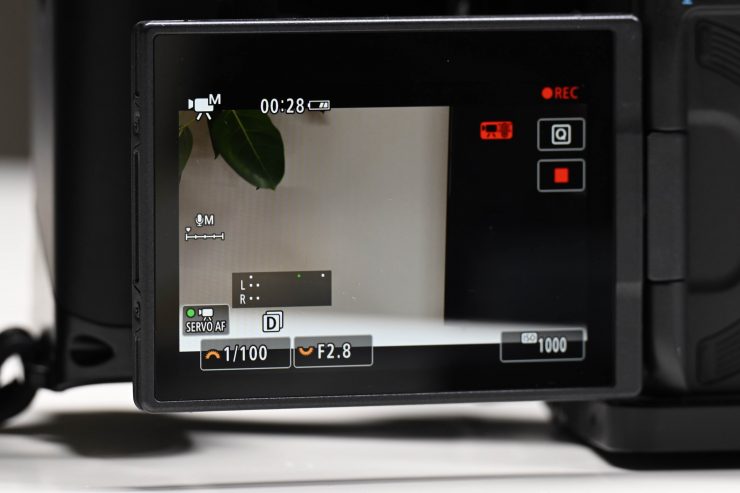
Once it started recording again the heat warning indicator was on from the beginning and the camera showed it could record for 28sec.
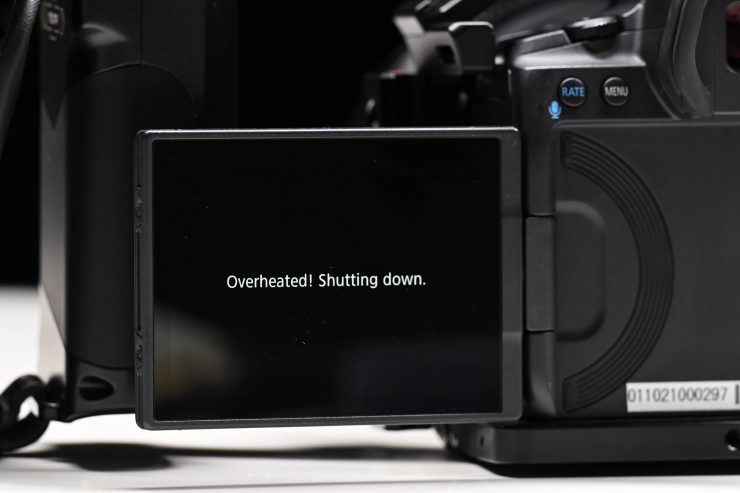
It actually lasted for 3min and 16sec before it shut down again.
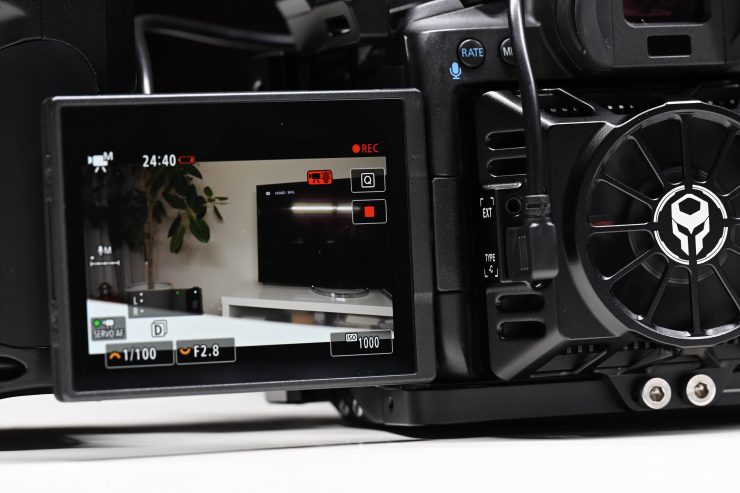
After waiting around 45min and installing the Tilta R5 Cooling Unit I conducted the same test again. Before pressing record, the camera was showing me that I could record for 25min. Interestingly enough, the heat warning indicator came on at 24min and 15sec which was earlier than when the cooling unit wasn’t being used. The camera continued to record up to its limit of 29min 59sec. The trouble is, once it stops recording you can’t just hit record again.
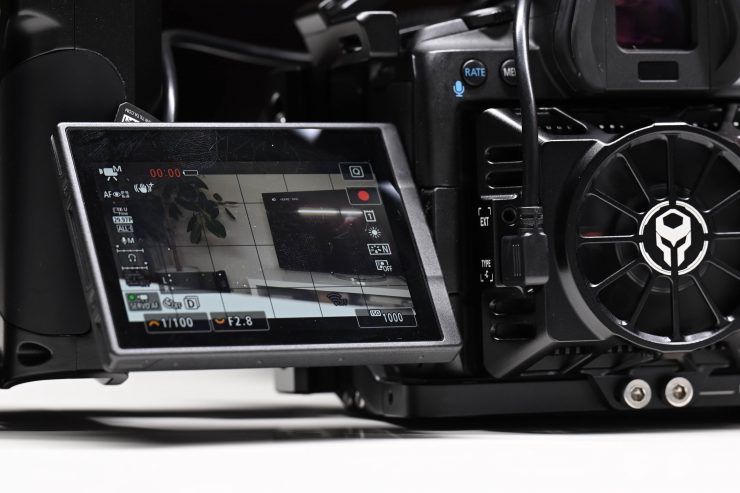
When I tried to record again straight away it wouldn’t let me. However, it was interesting to see that the heat warning indicator didn’t come on straight away and the camera didn’t actually physically keep shutting off. It stayed on, but I just couldn’t record.
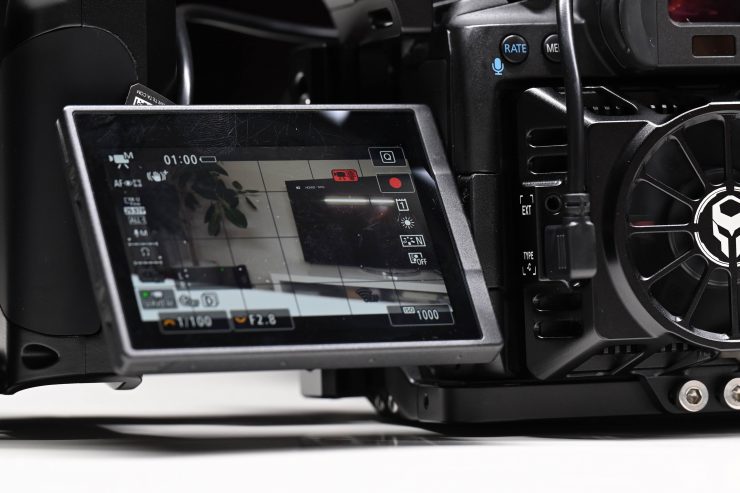
I had to wait for 2min and 18sec before I could start recording again. The camera was telling me I could only record for 1min, however, it ran for 8min and 22sec before it shut off again.
So, from this first test recording 4K HQ, I wasn’t actually able to get that much more recording time, although it did reach its max record time of 29min 59sec without shutting off. Here lays the issue. Once the camera stopped recording because it reached its max. recording time limit, you can’t just start recording again if the heat warning indicator was still on when it stopped. Essentially I think the camera could have kept recording for a lot longer than 29min 59sec if there wasn’t a recording time limit. The problem is there is a recording time limit!
The turnaround time before I could start recording again after the record limit was reached with the R5 and Tilta Cooling Unit was massively reduced down to just over 2min. This was substantially quicker than the 9min 3sec it took for it to start recording again without the cooling unit being used. The subsequent recording time also more than doubled over when the cooling unit wasn’t being used.
From this first test, it is clear that the Tilta R5 Cooling Unit does actually work, however, you are still hampered by the internal recording time limit. The recovery time for getting recording again was a lot faster, but it isn’t as if you can just hit record straight away. The only way to get around this would be to record for 20 or so minutes continuously and then stop and then hit record again. This would be the only way of getting increased recording without needing the camera to cool down.
So let’s do this 4K HQ test again, but this time we will use a USB-C power bank that is supplying 5V. I am doing this so that I can see if there are any differences from using an 8V USB-C power source.

Overall the results were reasonably similar, however, the time till you start recording when using the R5 cooling unit did increase out to 5min 3sec. The subsequent recording time also dropped down to 6min 35sec.
This shows me that the Tilta R5 Cooling Unit definitely does work better if you are powering it via an 8V USB-C source.
So, what about if we try and start recording over and over again after the camera shuts down?
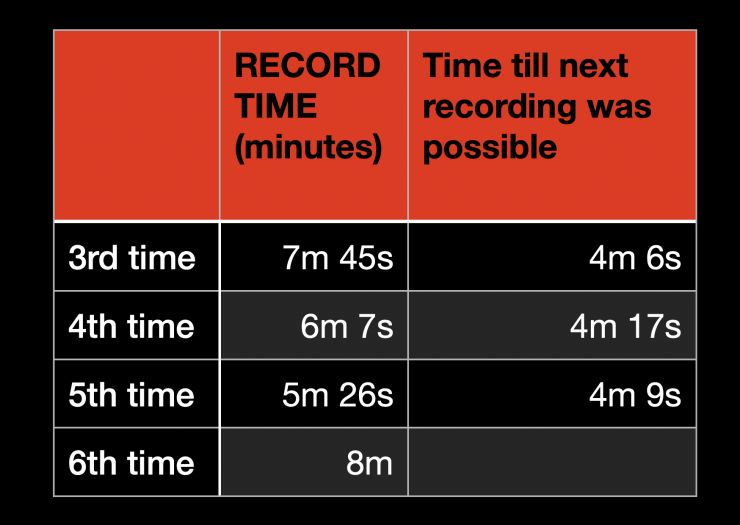
Above you can see that the subsequent record times bounced around between 5min 26sec up to 8min. The recovery time before you could start shooting again was consistently just over 4min. Please note that the card, nor the battery was removed between any of these tests.
After leaving the camera turned off for 1hour I then turned it back on to see how long it could record for. The camera showed me it could record for 20min, but it actually recorded for 29min 17sec before it shut off.
In 4K HQ mode, you are able to shoot up until the record time limitation with the cooling unit regardless of whether you are powering it with a 5-7.4V or an 8V source. However, you can get pretty close to doing that without using the cooling unit. The biggest difference is that it is quicker to get shooting again, and you can subsequently shoot for longer than if you don’t use the cooling unit.
8K DCI ALL-I Test
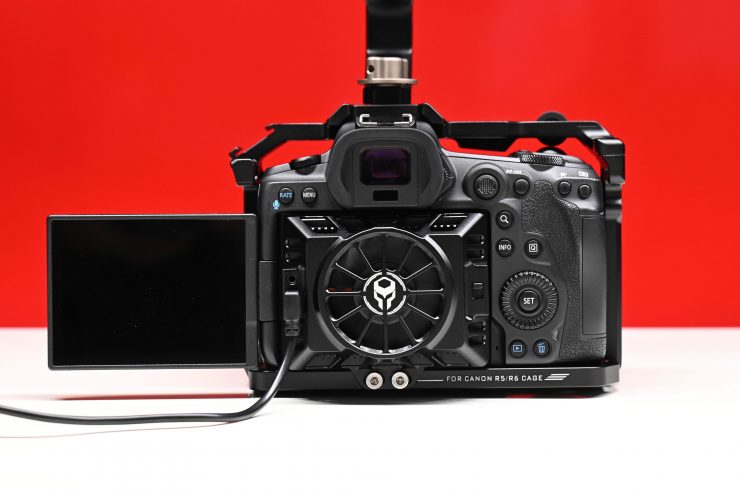
Ok, so we have seen how it works when recording in the 4K HQ mode, so what about if we record in 8K DCI ALL-I at 29.97p?
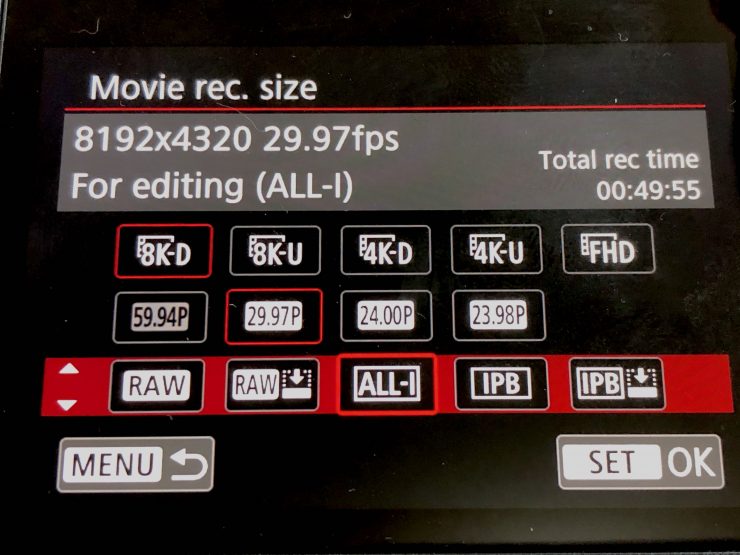
Again, we need a base to judge it by, so let’s see how much record time we can get when shooting 8K ALL-I without using the Tilta R5 Cooling Unit. For this test, the AF and IS were both on and the ambient room temperature was just over 28°C / 82.5°F. This was hotter than our previous 4K HQ tests.
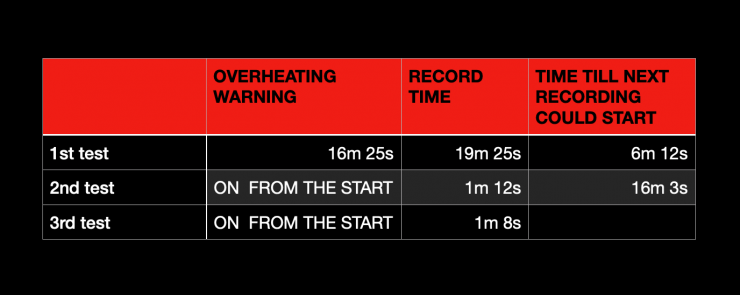
Above you can see that the overheating warning indicator appeared at 16m 25sec, but the camera kept recording up to 19min 25sec before it shut down.
I had to wait for 6min 12sec before I could record again and the camera told me I could only record for 1min. The R5 proceeded to record for 1min 12sec before it shut down.
I then had to wait a further 16min 3sec before being able to record again, and then the camera indicated only 1min of recording was possible. The R5 recorded for 1min 8sec before it shut down again.
Even 2 hours later, the camera only indicated that 10min of recording was possible. What was even more bizarre was that even after having the camera turned off for 6 hours it was still saying I could only record for 10min.
Ok, now that we have a base, let’s see what happens if we attach and use the Tilta R5 cooling unit and power it using a USB-C power bank that is supplying 5V.
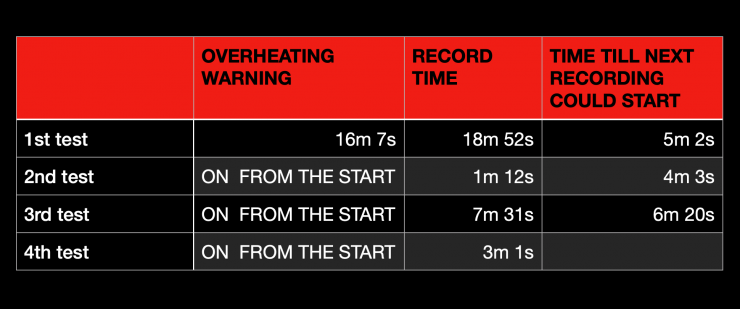
For the first test, the AF and IS were both on and the ambient room temperature was just over 28°C / 82.5°F. This was hotter than our previous 4K HQ tests.
The R5 was saying it could record for 15min, but it went for 18min 52sec before it shut down. The overheating warning coming on at 16min 7sec.
After 5min 2sec I was able to record again, but the camera was saying I could only record for 1min. The camera proceeded to record for just 1min 12sec before it shut off.
After waiting for 4min 3sec I could record again, but the camera was again telling me I could only record for 1min. The camera ended up recording for 7min 31sec before it shut down.
It took a further 6min 20sec before I could record gain. The R5 told me I could only record for 1min and it went for 3min 1sec before it shut off.
It was interesting to see that the initial record time was actually slightly less than when not using the R5 Cooling Unit, however, the recovery times were a lot quicker, especially on the subsequent recordings.
Overall, the results were not overly impressive and they didn’t make a drastic difference. Published results in a completely controlled environment are one thing, but people don’t always work in controlled conditions. In the real world, conditions are usually changing and if you are working outdoors then the ambient temperature is going to be different day to day. That is why controlled tests at a preset temperature will never show you how well a product will actually work.
For the second test, I wanted to see what happens if we run the R5 Cooling Unit with 12V, instead of 5-7.4V or 8V. What I noticed straight away is not only does the fan seem to be running faster, but the actual Cooling Unit itself also seems to get a lot hotter when it is being powered by a 12V source. For this test, the AF and IS were both on and the ambient room temperature was just over 28°C / 82.5°F.
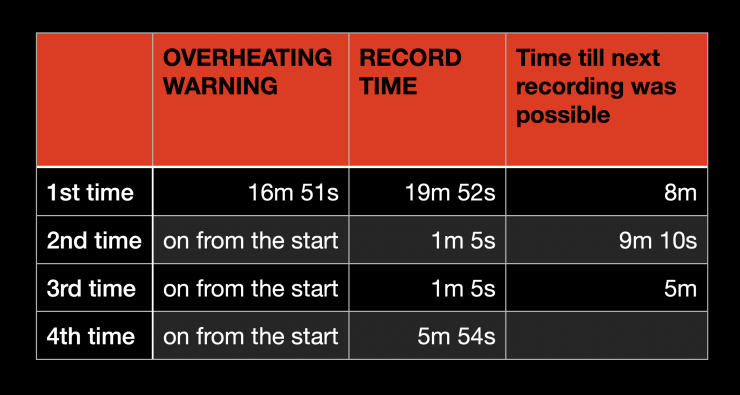
When recording 8K DCI ALL-I using the Tilta R5 Cooling Unit and being powered via a 12V source with the fan set to high, the camera recorded for 19min 52sec before it shut down. The overheating warning came on at 16min 51sec.
I then had to wait for 8min before I could record again and then the camera was telling me that only 1min of recording was possible. The camera ran for 1min and 5sec before shutting off. The overheating warning stayed on for the whole recording.
It then took 9min 10sec before I could record again. The camera told me I could record for 1min and again it went for 1min 5sec and then shut down.
For the fourth recording, I had to wait 5min to record. Again it said I could only record for 1min, but it ran for 5min and 45sec.
Ok, so what about if we leave the camera turned off for a while and try again?
After leaving the camera turned off for 45min, I turned it back on and it still said I could only record for 2min. The camera recorded for 7min 20sec before it shut down.
After turning it off again and waiting 34min, it said it could record for 1min, but it went for 6min 6sec before shutting off.
These tests showed me that when recording 8K DCI ALL-I and powering the Tilta R5 Cooling Unit via 12V, the results were not at all encouraging. The results weren’t that much different from when I didn’t use the R5 Cooling Unit. Yes, the recovery times were a little shorter, but the time I could actually record for didn’t change. Again, these tests were done in temperatures that were just over 28°C / 82.5°F.
The recovery times for the camera were better when using a 5V USB-C power source than a 12V one.
It seems as though you are much better off powering the R5 Cooling Unit via an 8V source than a 12V one.
8K RAW TEST
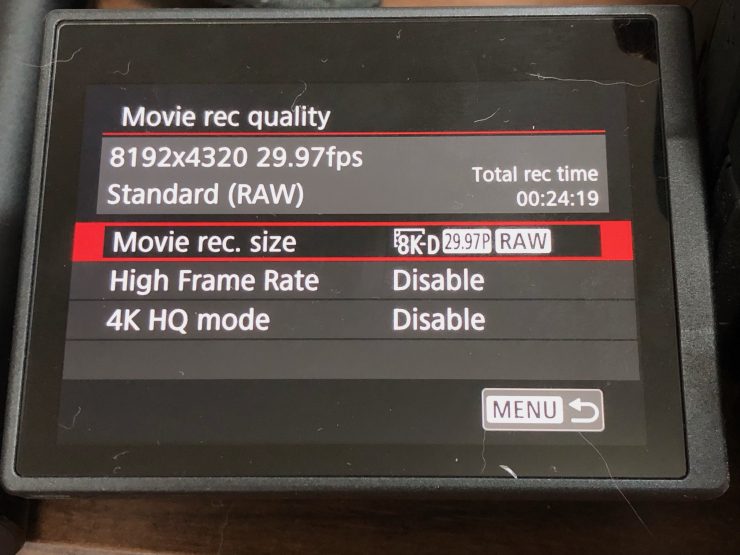
So now let’s do an 8K DCI RAW test and see what results we get.
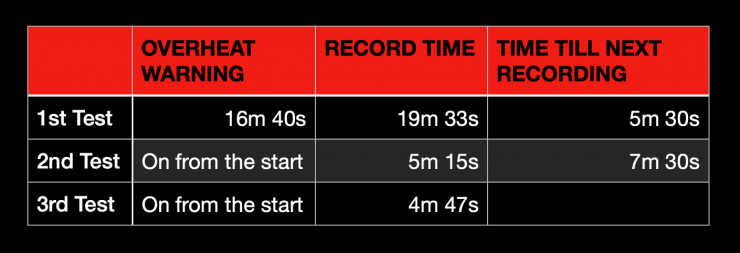
When recording 8K DCI RAW using the Tilta R5 Cooling Unit and being powered via a 5V USB-C source with the fan set to high, the camera told me it could record for 15min. It actually recorded for 19min 33sec before it shut down. The overheating warning came on at 16min 40sec.
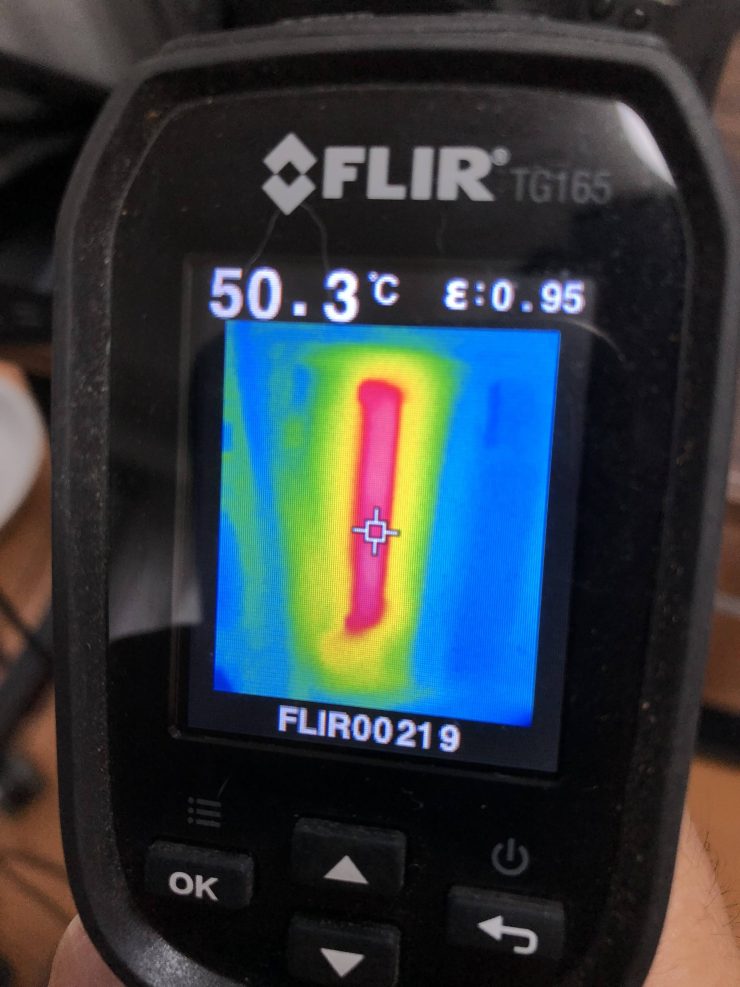
After the recording, if we measured the temperature of the back of the camera it was 32°C, inside the card door it was a whopping 50.3°C.
I then had to wait for 5min 30sec before I could record again and then the camera was telling me that only 1min of recording was possible. The camera ran for 5min and 15sec before shutting off. The overheating warning stayed on for the whole recording.
It then took 7min 30sec before I could record again. The camera told me I could record for 1min, but it actually recorded for 4min 47sec and then shut down.
For the fourth recording, I had to wait 5min to record. Again it said I could only record for 1min, but it ran for 5min and 45sec.
What this test showed me is that the camera is definitely getting hotter when recording 8K DCI ALL-I than when it is recording 8K DCI RAW. The subsequent recovery times and recording times after the camera initially shuts down are better when shooting 8K RAW than 8K DCI ALL-I.
Thoughts
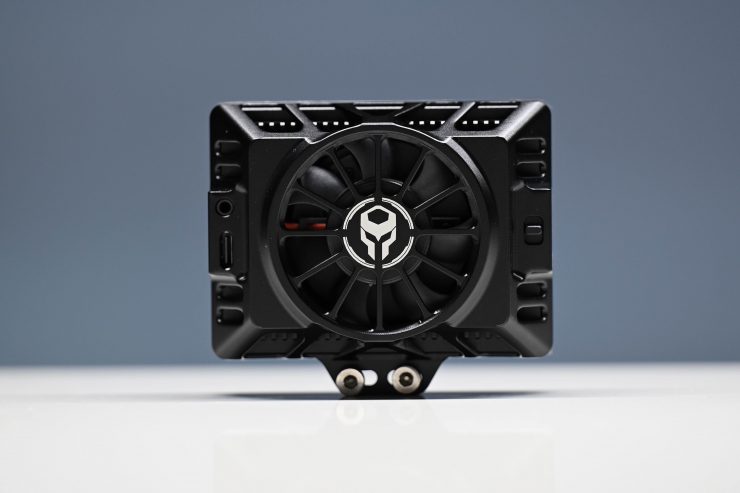
Look, you can’t blame Tilta for coming up with a solution for what is a real-world problem, regardless of how ridiculous this product first appears to be. The fact that a product like this even needs to be made in the first place points to a far greater issue.
Weather and dust-sealed mirrorless cameras are always going to be problematic when it comes to dispersing heat.
Depending on what type of work you do, the overheating issues with the R5 may be a problem for you, or they may not be. It really is going to depend on a lot of variables. Most of the overheating issues stem from long, uninterrupted recording times in the 4K HQ mode and the 8K RAW recording mode. If you are not rolling for long periods of time, then the heating issue may only rear its ugly head every now and then.
The biggest issues for me are having to power the cooling unit, the noise that it makes, and the usability issues.
The easiest way to power it and to get the best results is to probably just use Tilta’s Left-Side Advanced Power Handle with Run/Stop, or one of their handles that can output 8V over USB-C. The only problem is, these handles may not be to everyone’s liking. They also substantially increase the size and footprint of the camera.
It doesn’t at all appear to be beneficial running the R5 Cooling Unit via a 12V source. The fan seems to spins too quickly and the actual Cooling Unit gets quite hot. From my testing, I found that the actual recovery times and subsequent recording times were not that great compared to using no cooling unit.
That brings me to the second issue, noise. In a lot of instances if you are doing very long recording takes it is probably because you are shooting interviews or performances where critical audio needs to be recorded. This in itself, almost defeats the purpose of using the fan in the first place.
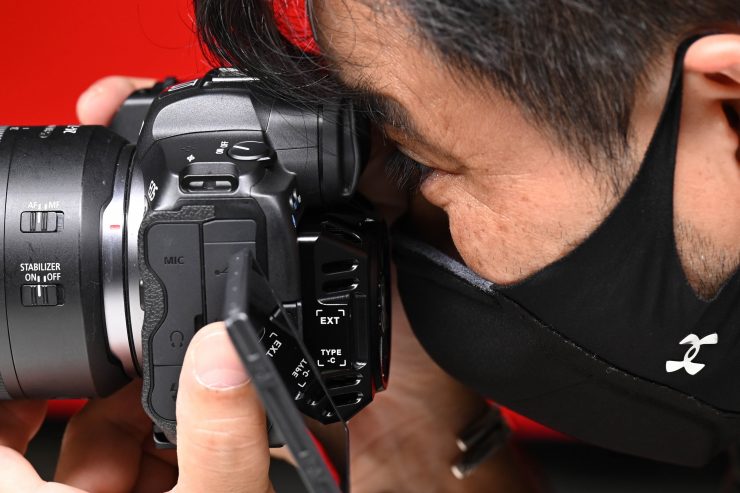
Usability does get compromised with the R5 Cooling Unit, regardless of whether you are using it in conjunction with the cage or as a stand-alone solution. You can’t put the camera up to your eye and use it when the fan is on and you have to have the screen folded out to use it.
If you don’t like the idea of strapping a fan to the back of your camera and having it there while you are shooting you could just use it to help cool down the camera when you aren’t shooting by attaching it and plugging it into a power source.
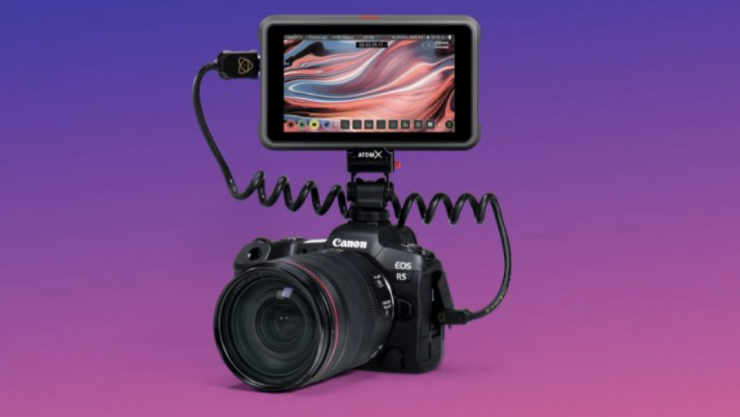
If you want to record 8K RAW, then the best bet is to just use an Atomos Ninja V+ so you don’t have to worry about constant overheating issues.
Surprise, surprise, the Ninja V+ has fans, so guess what, it can disperse heat. This is the inherent problem with using cameras that don’t have fans and that are fully sealed. It is the equivalent of sitting in a car on a hot day with the air conditioning off and the windows up. Where can the heat go?
Could you be potentially damaging your camera?
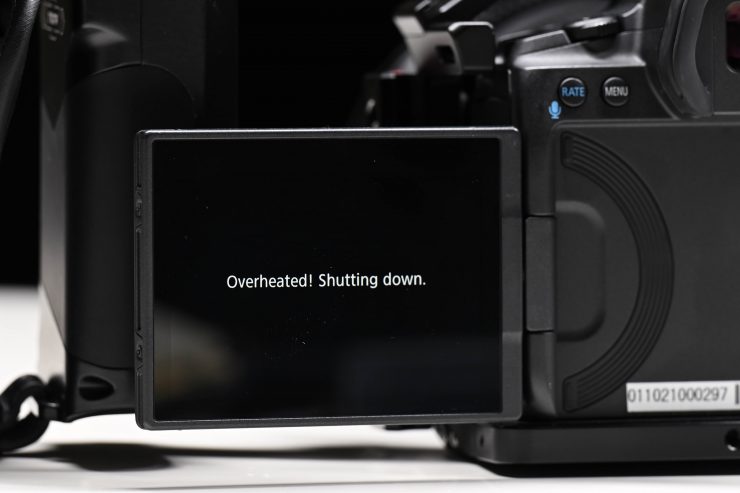
The other issue is that when a heat indicator warning does come on, it comes on for a reason. It is telling you that the camera is starting to get too hot and you really should turn it off. The internal temperature mechanism inside the R5 is set to turn the camera off once it reaches a certain temperature. Look, you can complain all you want about temperature warnings, but they are there for a reason. You wouldn’t continue to keep driving your car around for ages after an engine temperature warning light came on in your car. Manufacturers set limits to balance performance and reliability. If you talk to Canon they will tell you that continuing to run your camera even after heat warning indicators come on is not a great idea. Over a period of time, you may end up damaging your camera.
Price & Availability
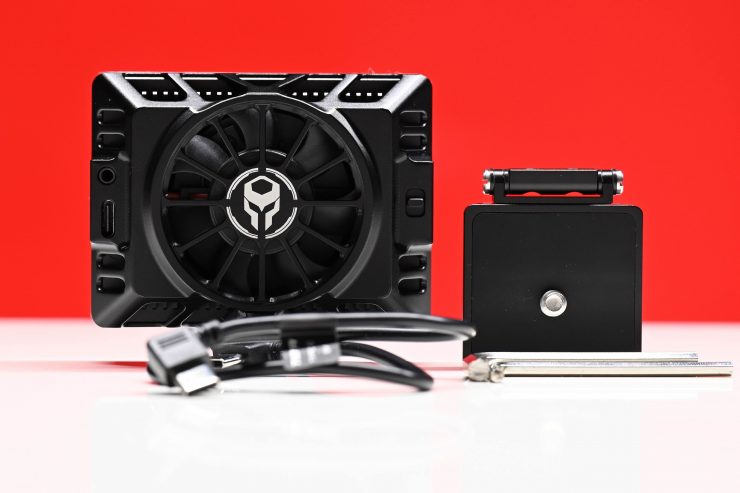
The Tilta R5 Cooling Unit can be purchased for $165 USD. This is not overly expensive, but it also isn’t $50 either.
Conclusion
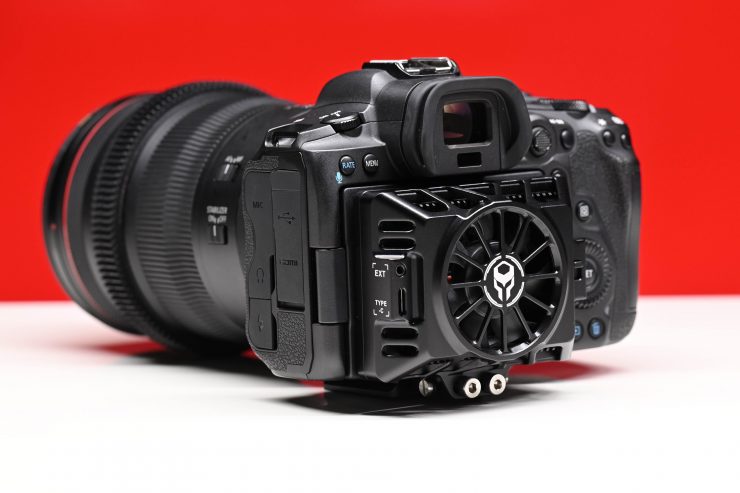
In a lot of ways, the Tilta R5 Cooling Unit is a niche product, but it does actually work. However, you would have to decide whether or not it is worth the hassle of using it just to get some extra recording time. It is certainly not a miracle solution, and it is more of a bandaid that temporarily solves the problem.
I am no expert on the subject, but it appears that using an external cooling solution such as a fan can only do so much. It isn’t going to be as efficient as changing the heatsink inside the camera.
I also found that depending on ambient temperature, the input voltage that is being used for powering the Cooling Unit, and the card you are using, it is virtually impossible to get a definitive answer to how much improvement you should expect.
There are so many variables that factor into how well the Tilta R5 Cooling Unit will work.
Kolari’s passive R5 cooling solution is probably a better long-term solution, however, you are going to void Canon’s factory warranty if you get that modification done. With the Tilta solution, you are not voiding Canon’s factory warranty because you are not having to alter anything internally in the camera. You can also remove or put back on the R5 Cooling Unit anytime you want.
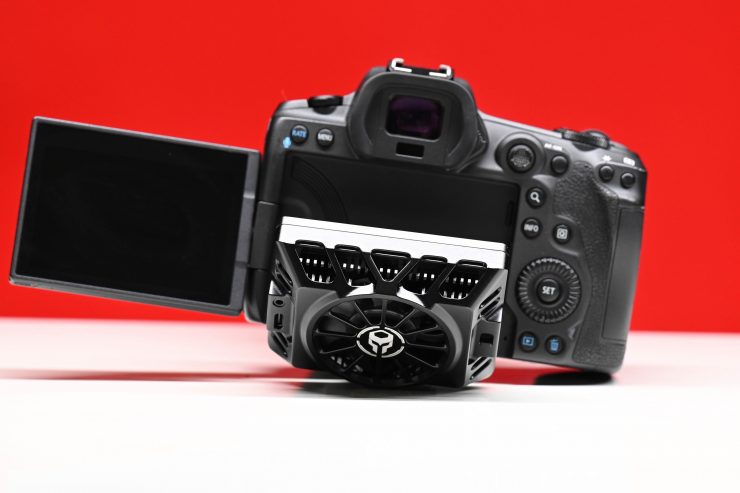
The Cooling Unit needs to be externally powered, the fan does make a lot of noise in the high setting, and it does certainly affect usability. You can’t have your cake and eat it too. For a lot of R5 users, they probably wouldn’t need a product like this, but for others, it may be a welcome addition to their kit. It really comes down to what you are shooting and if you really need to shoot in 4K HQ or 8K RAW.
My advice is that if you need to record 4K HQ, 8K ALL-I, or 8K RAW, just do it externally to a recorder so you don’t run into issues.
Is this a product you would actually buy? Do you own an R5 and are still looking for solutions to the overheating issues? Let us know in the comments section below.

